

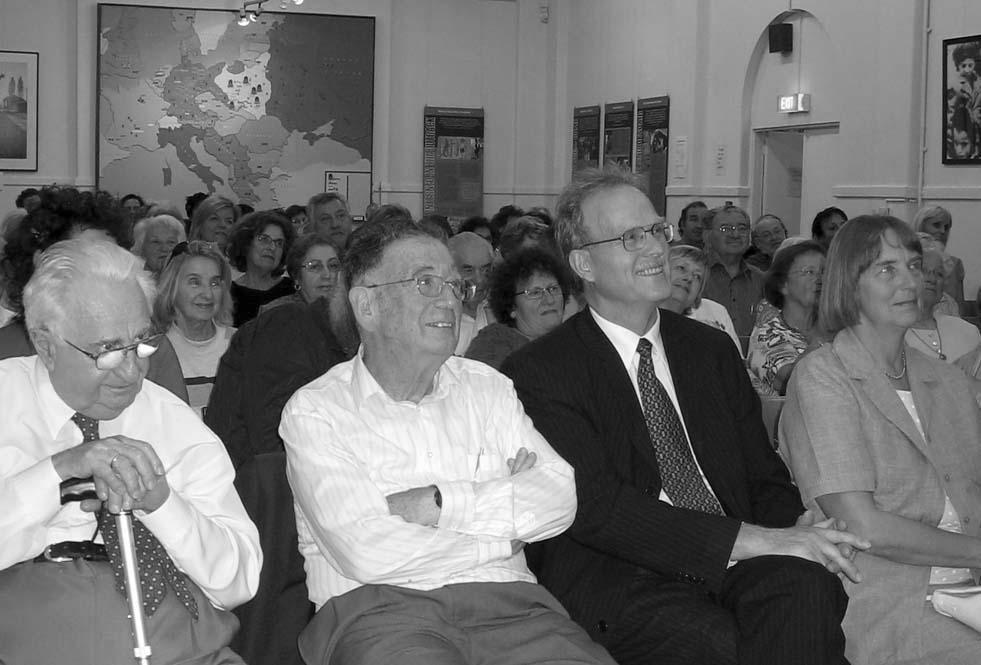
VOL. 29, No. 1 APRIL 2007 Registered by Australian Post, Publication No. VBH 7236 Registered Museum Under the Patronage of “Yad Vashem” Jerusalem 13-15 Selwyn Street, Elsternwick, Victoria 3185, Australia, Phone: (03) 9528 1985 Fax: (03) 9528 3758 Email: admin@jhc.org.au Website: http://www.jhc.org.au PROFESSOR YEHUDA BAUER LECTURES Capacity house attend Professor Yehuda Bauer lectures at Centre.
The Jewish Holocaust Museum and Research Centre is an Institution dedicated to the memory of the six million Jews who were murdered by the Nazis and their collaborators between 1933 and 1945.
We consider the finest memorial to all victims of racist policies to be an educational program which aims to combat anti-Semitism, racism and prejudice in the community and fosters understanding between people
Holocaust Centre Executive
Co-Presidents: Shmuel Rosenkranz & Pauline Rockman
Vice-President: Alex Dafner
Chairman: Harry Bryce
Co-Treasurers: Allen Brostek & Abram Goldberg
Secretary: Helen Mahemoff
Public Relations & Centre News Editor: Stan Marks
Foundation Patrons
Sir William Deane, Sir Gustav Nossal, Steven Spielberg, Professor Yehuda Bauer, Mrs. Diane Shteinman AM, Mr. Marc Besen AO, Mrs. Eva Besen.
Centre News
Editor: Stan Marks
Editorial Assistance: Shmuel Rosenkranz, Lyla Burston & Lena Fiszman
YOU CAN MAKE A DIFFERENCE —MANY WAYS TO SUPPORT YOUR HOLOCAUST CENTRE
Stan Marks
Two of the vital features urgently needed to keep a Holocaust Centre in existence are dedicated volunteers and funds. Both are essential if the message of the Holocaust and its growing relevance in today’s uncertain world (of increasing anti-Semitism, racism, prejudice, hatred and even genocides) are to be explained, especially to future generations, our future leaders. The Melbourne Holocaust Centre, the heart of Australia’s Holocaust remembrance, is making an everincreasing contribution to fostering understanding and curbing the man-made ills that bedevil our small Planet.
The Centre in a wide-ranging program aims to foster understanding of each other. It has numerous activities to which you can make a definite contribution, as a volunteer, participant, visitor or donor. Your contribution can make a difference. This is even more pertinent as survivor volunteers age and cannot carry on, particularly in the extensive education program for Victorian Secondary Schools. Students gain a unique insight into what it means to be a survivor . Volunteers are needed to take over from these survivors.
The Centre also conducts regular lectures and short courses, open to the public. Younger men and women are quickly made welcome and assisted in all ways. There is a permanent exhibition, an ongoing program of recording testimonies, a multi-lingual library, archives and, among other features, a book shop. It is planning to upgrade the main exhibition area, and ensure the Centre has the latest communications equipment to get its message across, including Holocaust denial. Funds are required to carry out all these activities.
This is where you the can assist. Become a volunteer. Perhaps you have a special interest, talent or ability which could be utilised at the Centre. Or make a donation, large or small towards the Centre’s activities, now or even in your will, as a lasting legacy of your contribution to understanding. You can donate by filling out the pledge form on page ? of this issue of Centre News or calling the Centre or Foundation member on 9528 1985.
I wish to thank the many hundreds of people who have congratulated me, with cards, emails, letters, calls or in other ways, on receiving an Australia Day Honours award. It has been very heartening, especially the wording including my work for the Jewish community, particularly the Holocaust Centre. I thank all who have assisted and cooperated with me over many years. An award for the whole Jewish community.
Stan Marks
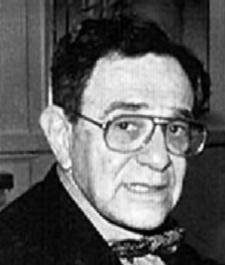
2
Yiddish: Moshe Ajzenbud CONTENTS Editorial 2 UN Holocaust Memorial Day 3 Top Literary Award for Survivor 6 Centre receives overseas recommendation 7 “Art and the Holocaust” Lectures at NGV 7 “The Boy in the Striped Pyjamas” 8 My First Year as Co-President 12 Testimonies Department and Projects 13 USA Stamp recognises Saviour 14 The Meaning of Genocide 14 Holocaust Centres and their message 15 Who was Dietrich Bonhoeffer? 17 Images Speak in Documentary 18 Death of Two Centre Volunteers 19 Hitler, the Cultural Planner 20 Primo Levi 21 Book Review: “Alien Roots” 22 Famous Aboriginal’s Great Grandson at Centre 23 “Herr Honig and the Wannsee Conference” 23 Child Survivor Awards 24 Fascinating story of German Migrant 25 Montreal Holocaust Memorial Museum 26 Importance of Holocaust Studies 27 Archives 30 Personal Announcements 31 Make A Pledge Form 37 Yiddish 38 Cover: Shmuel Rosenkranz,
Bauer,
Survivors’ Work in Canadian University 28 Survivor Art Works Sought 28 Scholar at joint Melton and Centre Evening 29 Argentinian Academic visits the Centre 29
Professor Yehuda
German Consul-Gemenal, Thomas Kessler and Mrs. Elke Kessler.
*****
PRIME MINISTER JOHN HOWARD’S MESSAGE
I am pleased to provide a message on the occasion of the Melbourne Holocaust Centre’s commemoration of 27 January 2007.
In November 2005 the General Assembly of the United Nations resolved to designate 27 January as an annual International Day of Commemoration in memory of the victims of the Holocaust. Australia cosponsored this important resolution, which urges people of all nations to remember and learn from the tragic events of that period and to commit to educating current and future generations about the dangers of racism, prejudice and xenophobia.
Australians will never forget the unmitigated evil which led to the murder of six million Jews and countless thousands of others in Nazi concentration camps.
I am proud of the fact that Australia and in particular Melbourne was to become home for many Holocaust survivors. I commend the Melbourne Holocaust Centre for organizing this commemoration.
MANY RELIGIONS, VICTIMS & OTHERS COMMEMORATE CENTRE'S UN HOLOCAUST DAY
They came from different religions, from all walks of life, from Jewish Holocaust victims and victims other than Jews, to join the crowded main hall at the Holocaust Centre on January 28, to commemorate United Nations International Holocaust Remembrance Day. The designated day is January 27 (when Auschwitz was liberated) but it fell on a Saturday, hence the Sunday commemoration.
More than 250 people crowded the main hall to hear a message read from Prime Minister John Howard; many speakers including keynote ones: The Most Reverend Christopher Prowse, Catholic Archbishop of Melbourne and George Lekakis, Chairman of the Victorian Multicultural Commission; Geoffrey Zygier, Executive Director of the Council of Australian Jewry; survivor Lusia Haberfeld; Eliza Egan, Penleigh & Essendon Grammar School; Pauline Rockman and Shmuel Rosenkranz, co-presidents of the Holocaust Centre; Bernard Korbman, (Acting) Executive Director of the Holocaust Centre and representatives of the disabled, homosexuals, gypsies and for the Jehovah Witnesses, who lit candles, remembering that they too were also among the Holocaust victims.
It was an emotional afternoon, men, women and children wept as speakers told of the Holocaust, and especially its relevance in these uncertain times. Its Mission Statement, stressed to the thousands of students who annually visit the Centre, was underlinedTo remember the Holocaust and combat racism, hatred and prejudice and foster understanding among all people at home and abroad. To consider the Holocaust's vital message for these times.
UNCHECKED INTOLERANCE
George Lekakis said: As you may know, it was a little more than a year ago that the resolution for establishing International Holocaust Memorial Day was adopted by the United Nations General Assembly by consensus. It was understood that the world must never forget that Auschwitz and the Holocaust were the inevitable result of unchecked intolerance,
discrimination, oppression, bigotry and hate.
Indeed, as we observe the date of the camp’s liberation – and as cited in the U.N. resolution - we are reminded that, along with Jewish people of all nationalities, minorities in general were also targeted during the Nazi reign of terror. Handicapped people, political activists, trade unionists, homosexuals, Slavs and gypsies, all were to be expunged from the face of the earth. All in the name of security for the Third Reich.
And so I come to the question posed by the theme of this year’s Holocaust Memorial Day - “What has the world learnt?” In recent memory acts of genocide or mass murder have occurred in Rwanda, in Bosnia and elsewhere. The director of the University of Melbourne Centre For Jewish History and Culture, Dr Dvir Abramovich, calls the carnage in Darfur the first genocide of the 21st century. Some experts are predicting the Darfur death toll to exceed one million.
So, what the world has learnt is that human rights abuse recognises no national, cultural, religious or racial boundaries, and past and present history evidences atrocities committed all too often in far too many parts of the world. During this time of global volatility, as national security fears clash with established principles of justice and human rights, the United Nations International Holocaust Memorial Day provides a timely warning.
For what use are the Universal Declaration of Human Rights, the Genocide Convention, the International Criminal Court and indeed the United Nations itself, if we cannot put an end to these cycles of systemic aggression and abuse that so demeans us as individuals and condemns us as a species.
And yet it’s a startling truism that the species that spawned Hitler also produced Mahatma Ghandi, Albert Schweitzer, Martin Luther King and Nelson Mandela. As human beings we possess a marvellous and unique ability to create, to nurture, to shape the world around us.
That shape must bear no resemblance to the gates of Auschwitz. Not ever.
VICTORIA’S RECORD
Here in Victoria we have a remarkable record of
3
multicultural community harmony. It is a social reality that we have created in this country and cannot be denied. To acknowledge, support, cherish and celebrate our diversity is a test of leadership and vision.
We must encourage everyone to work together in a context of mutual respect with the ultimate vision of a safe, prosperous, fair and egalitarian Australia for all of us. The people of Victoria come from more than 230 nations, speak more than 180 languages and dialects, and follow more than 110 faiths.
Arguably, we live in the one of the most stable and cohesive societies in the world. But it would be foolish to deny that we still confront the ugly side of intolerance. Even so, we are vigilant and alert to it and take every opportunity to work together in overcoming any aspect of it.
My personal recollection of the Holocaust has shaped my thinking through 30 years of community service, and as Chairperson of the Victorian Multicultural Commission I have endeavoured to combat any policy or action that exacerbates social division, bigotry or systemic discrimination.
I am pleased to say that in this regard Victoria’s Jewish leadership continues its vanguard role. Working together, we are able to not only maintain Victoria’s good multicultural name but to develop, support and promote our cultural, linguistic and religious diversity for the benefit of all Victorians. Thank you.
BISHOP’S COMMENTS
Bishop Prowse said: This is my third time to visit the Jewish Holocaust Centre over the last couple of years. It is an honour to be invited as a friend of the Centre and, of course, a friend of the Jewish people in Melbourne. As you know, I represent the Catholic community of Melbourne. There are over one million of us in our city.
Our two communities – the Jews and the Christians - have had a wonderful relationship together in Melbourne over 20 years in the Council of Christian and Jews. The journal “Gesher” chronicles this journey together.
Just as we can look at a beautiful diamond from all different perspectives and wonder at its creation, conversely, we can surely look at evil from different perspectives and condemn its very existence. This condemnation of the mystery of evil is what we do when we reflect once again today on the Holocaust.
The Catholic perspective of this evil is perhaps best described for us by the Pope, His Holiness Pope Benedict XVI. On 19th August 2005 he visited the synagogue of Cologne and spoke to the Jewish community. He said, “The history of relations between the Jewish and Christian communities has been complex and often painful. There were blessed times when the two lived together peacefully, but there was also the expulsion of the Jews from Cologne in the year 1424.
”And in the 20th century, in the darkest period of German and European history, an insane racist ideology, born of neo-paganism, gave rise to the attempt, planned and systematically carried out by the regime, to exterminate European Jewry. The result has passed into history as the Shoah.
“I make my own the words written by my venerable Predecessor (John Paul II) on the occasion of the 60th
anniversary of the liberation of Auschwitz and I too say: “I bow my head before all those who experienced this manifestation of the mysterium iniquitatis.”. The terrible events of that time must “never cease to rouse consciences, to inspire the building of peace”(15th January 2005).
I wish to reflect a moment on this last double response to the Holocaust - to rouse consciences and to inspire the building of peace.
First, what we are doing today is to rouse our consciences. We humans have an enormous capacity for personal and social deceit and forgetfulness in regard to evil. The horror seems too shocking for us to linger for any length of time. But we must do this. We must examine, for example: Why it happened? How it happened? Who was affected? What was their story?
Evil goes out in a systematic way and attempts to hide itself in darkness and in the fog of human consciences. Evil can reappear at a later time in another disguise and another manifestation.
This we have learnt in these intervening 60 plus years. We must be vigilant and condemn immediately the reappearance of this evil. In its important document on relations with Jews (Nostra Aetate, 1965), the Catholic Church “condemns as foreign to the mind of Christ any kind of discrimination whatsoever between people, or harassment of them, done by reason of race or colour, class or religion (n.5).”
Secondly, however, this arousal of conscience must lead “to inspire the building of peace”. There is a felicitous statement found in an important document by the Catholic Church (1998) called, “We Remember: A Reflection on the Shoah”. It reads: “However, it is not only a question of recalling the past. The common future of Jews and Christians demands that we remember, for “there is no future without memory”.”(n.3). The victims from their graves, and the survivors through the vivid testimony of what they have suffered, have become a loud voice calling the attention of all of humanity. To remember this terrible experience is to become fully conscious of the salutary warning it entails: the spoiled seeds of anti-Judaism and anti-Semitism must never again be allowed to take root in any human heart.”
We are here today because we have learnt that peace is an ongoing task. Its work never finishes. These evil and spoilt “seeds” must never again find a fertile home in the human heart. It is a task of education and, even beyond, that, of conversion of the human heart. For just as evil starts in the human heart, so can grace and peace flourish. You and I believe in our hearts of hearts that love is stronger than evil and fear. Indeed, love is our common future.
STUDENTS
Eliza Egan, Penleigh & Essendon Grammar student said: An important part of the school’s curriculum is to provide an enhanced learning experience. And so, last May, my year level, accompanied by our history teachers, visited the Jewish Holocaust Centre as a part of our WWII studies. The excursion was very poignant and made everyone truly feel the horrors and devastation of the Holocaust.
When we first arrived, as you would have
4
experienced today, we saw the entrance, with the iron statues depicting the suffering during the Holocaust. This made everyone feel attentive about what we would experience and observe during the day.
From there, we saw a video and were then separated into two groups to listen to a personal account of the Holocaust from a survivor. In these smaller groups, there was a much more personal feel, and our speaker narrated her experiences, with heartfelt and genuine emotion. It was captivating and we were engrossed listening to what she endured. I believe all of us had deep respect and admiration for her and it made us understand what occurred during the Holocaust and how it affected so many people. Many of us had previously viewed World War Two from a passive perspective, believing it occurred so far away and so long ago from us, and as a result, we did not understand the war.
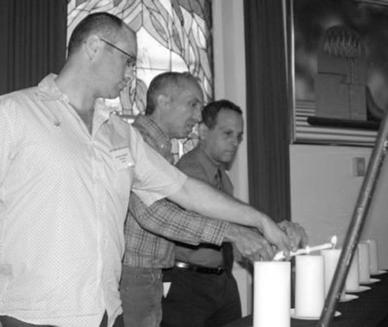
VISITED AUSCHWITZ
I personally visited Auschwitz four years ago and was deeply moved by my experiences at the memorial centre there. I was with my family and the first thing I saw when visiting was the gate with: ‘Arbeit macht frei’work makes you free. This lie, which so many people based their fight for survival on, was a chilling reminder that terrible destruction did occur. A horrific image that also is preserved in my mind is the huge size of the place and the long train line travelling into the centre of the neighbouring camp, Birkenau. These experiences have also given me an insight into the suffering that was endured by the victims and their fight for survival.
Even though the Holocaust occurred 68 years ago, one would expect that our society, as a whole, would continue to be affected by the genocide and pay


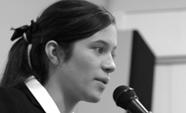
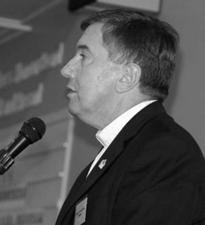
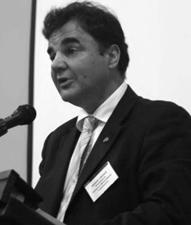
remembrance to those who lost their lives. This is true, as there are memorials for the Holocaust across the world; people are educated about it; and, we are frequently reminded of it. However, genocide is still occurring today. Genocide, as defined by the Britannica Encyclopaedia is “[the] Deliberate and systematic destruction of a racial, religious, political, or ethnic group … and may be committed by an individual, group, or government, against one’s own people or another, in peacetime or in wartime.”
To me it is inconceivable that, as horrific as the death camps were, genocide has occurred a number of times since. In fact, in the last fifteen years, three acts of genocide have occurred, as recognised by the United Nations: in Bosnia, from 1992-1996; in Rwanda, for 100 days in 1994; and in Darfur, which began almost four years ago; genocidal acts have occurred. More than half a million people have been killed during these acts, and the Darfur incident, in particular, still continues today.




The terrible suffering and destruction of human life did occur during the Holocaust and even today, people find it hard to understand how such a monstrosity could occur. Yet today, genocide continues. This demonstrates just how important it is for all of us to be educated about previous acts of genocide and do all in our power to prevent it occurring in the future. However, through personal experiences such as visiting the Holocaust Memorial Centre, visiting the Auschwitz Concentration Camp and through people protesting against genocidal acts, hopefully we can stop such devastating events from occurring again.
And so, we need to constantly remind ourselves of this because, in the words of the famous American philosopher, George Santayana, “Those who can not remember the past, are condemned to repeat it.”
5
Victorian Multicultural Commissioner, George Lekakis.
Bishop Christopher Prowse.
Student, Eliza Egan.
Survivor, Lusia Haberfeld.
Lighting a candle for the Gay community: Michael Barnett (President, Aleph), Colin Krycer (Aleph) and Demetry Apostle (Vice-President, AGMC).
FROM AUSCHWITZ TO TOP LITERARY AWARD
Stan Marks
It’s a long way, an incredible journey from Auschwitz to some of Australia’s top literary awards, but Holocaust survivor and Centre News contributor Jacob Rosenberg has shown it can be done.
in the world? Never ending questions.
Words, communicating, truth, justice, loyalty, understanding, religions world-wide, family are just some of the arresting mix that are on Rosenberg’s mind almost every minute of every day. In his 80s he is as inquiring as ever. When many are playing bowls, bridge or wondering where all the years have gone, Rosenberg is busier than ever and always raging against the dying of the light.
Rosenberg told me that writing, especially poetry, was not only the epitome of all art; it was the incandescent light in the dark dwellings of history, in the dim abode of the eternal human drama- a torch that guides us, in any epoch, into the most human corners of the hidden heart.
Rosenberg’s latest literary achievement has been the $20,000 Australian National Biography Award for his memoir “East of Time”, which describes in an engaging way the events and people of his early life. It is in its third Australian edition and will be published in Israel, the United States and Poland. He has also won other prestigious Australian literary awards. A play he wrote about Shakespeare was recently read by some of Australia’s leading actors at The Malthouse.
Could Shakespeare have been Jewish or even had Jewish links from Spain and dating back to Henry V111? A capacity housed audience left pondering Rosenberg’s many questions.
And he has already working on a sequel to “East of Time”, titled “Sunrise West”, expected to be published in September this year.
Polish born, Rosenberg and his family were taken to Auschwitz in 1944. Only Jacob survived. He describes Auschwitz as beginning with the letter “A” and ending with the letter “Z”, adding he was bothered by its being almost kabbalistic.
Talking to Jacob Rosenberg is a memorable experience. I can easily imagine him wandering in the desert with Moses or sitting arguing with Judaism’s greatest teachers, its famous rebbes and, above all, agreeing or disagreeing with the sages on many different beliefs and opinions, even questioning God. Asking so many questions, so many whys, ranging from the arguably definitively beginnings of history to problems in Jewish communities today at home and abroad.
What a treat it would be to be a silent diner at a dinner with Jacob, Abraham, Rashi, Budda, Mohammed, Jesus and others. Rosenberg would hold his own, indeed, even give a lead. Provocative thoughts straight from Rosenberg’s fertile mind. Above all, how he sees and feels about today’s world and the place of Jewry, including in Australia.
AUSTRALIAN JEWS
What should be the ethos of the local Jewish community? Where should the Holocaust Centre be heading? How should it reach the young, especially after the survivor guides have gone? What of Israel’s position
Rosenberg captures life in all its enigmatic, beautiful, ridiculous, horrendous, amazing, delightful and absurd situations. In a simple, but memorable manner, he contributes to a writing tradition going back into Jewish history.
His achievements , like many other Holocaust survivors including those who have written their memoirs, are doubly praiseworthy. He spoke little, if any English, when he arrived in Australia after WW11.

IMPORTANCE OF LANGUAGE
But he says he fell in love with the English language, and also Australia from his first day here. The absolute freedom, the air, the light, the people. “We must safeguard it in a rapidly altering world, he said, “It is a rare and beautiful land.”
He insists students, especially in Australia, should know about the world of yesteryear, including the Holocaust and the lost world of European Jewry, and possibly armed with knowledge of the past, help stop repeating its mistakes.
Somehow, we have got to learn past lessons.
He insists we must know who and what we are, and where we come from.
He is dedicated to spreading an understanding of languages, especially English.
”I love the English language,” he adds. “It is so rich like a living organ, constantly renewing itself. When you consider all the words in English, it is wonderful. I can’t read enough in English, a language we should all cherish.”
He sometimes rewrites a poem or a sentence in a book more than a dozen times to ensure he has the right word or phrase. He has no trouble in writing anywhere.
He emphasises “If you want to write, you will find a way.”
Rosenberg has the air of a modern, but more realistic, “Man of La Mancha”, ready to get on his faithful steed and battle the injustices, hatreds, lack of understandings and also look for answers to the seemingly endless problems plaguing the world.
The Jewish community can be proud of Jacob Rosenberg and his very supportive wife, Esther. Centre News extends its heartiest congratulations to the “Man from Poland” who had become a fair dinkum Aussie. I look forward to his next book and many more.
6
Jacob Rosenberg
HOLOCAUST CENTRE
A group of Asian students and teachers recently visited the Holocaust Centre after hearing about it in New York. While visiting a Jewish Museum in New York, they told an official they were going to Australia. The official said that when In Melbourne they should definitely visit its excellent Holocaust Museum, and they would find it very rewarding. Apparently the New Yorkers had the highest praise for the Melbourne Holocaust Centre - a must see and feel experience.
The group took the New York advice and spent many hours at the Centre. They took many photos of “our memorable visit.” They insisted they would tell others about their trip and how important the Melbourne Centre was in fostering understanding. “It is a must when visiting Melbourne, with such wonderful and helpful guides.”

They sent the following joint comments to Centre News:
Our recent visit to the Melbourne Holocaust Centre was the translation of what we think we know into what we “experienced” about the Holocaust. We could almost hear the desperate silent cries for help; smell burning flesh and see skinny bodies wrapped only in skin to shield themselves from the atrocities.
We had the greatest opportunity to meet with some of the survivors of this most disturbing and tragic event in human history. As we sat there listening to their accounts, we suddenly felt totally vulnerable and overcame with unthinkable fear. We were unable to hold back our tears. We would like to extend our utmost thanks to the survivors for sharing their lives

“ART
AND
with us. If not for this, we would never have had this experience. They walked us through a “torture museum” when we could have asked for it to be stopped, but we did not.
Despite what happened to the Jews during the Second World War, atrocities continues to be committed against our “own” flesh and blood around the world in countries like Cambodia, Croatia, and Rwanda.
We strongly recommend that for those who wish to go through such an “experience”, they should visit this centre in Melbourne and learn how such atrocities can be avoided. In the word of David, “the world must have greater tolerance towards each others’ differences”. Let us not allow history to repeat itself.
“An eye for an eye makes the whole world blind” a quote by Mahatma Gandhi
THE HOLOCAUST” LECTURES WITH NGV
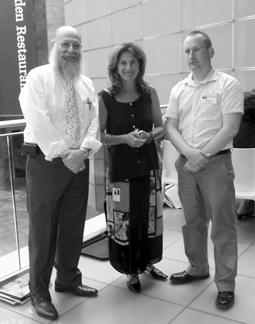
A move is being made to hold a series of lectures this year between the Centre and the National Gallery of Victoria on “Art and the Holocaust.
This follows a lecture on “Understanding the Holocaust, Genocide and Mass Killings” at the Gallery by Bernard Korbman, the Centre’s acting Executive Director.
Korbman explored and highlighted the sanctity of human life and the challenge for teachers to bring these stories to life. He developed the theme of the Nazi machine being powered by creative propaganda which enabled the rise of anti-Semitism through the persuasive utilization of the arts – in language, music, literature and in folklore art, through the use of stereotypical caricatures and symbols that depicted Jews as “the other” and anti-Aryan.
The teachers from various Victorian schools were guided through 2,000 years of Jewish history and the development of anti-Semitism. As a former history and art teacher, Korbman also graphically painted a picture of the Jews before the Holocaust and the richness of life – cultural, religious and communal that existed for thousands of years in Europe and the Middle East.
Important questions were answered, worthwhile associations made and many of the teachers s said they would bring students to JHC in the future.
The proposed initiative as well as exploring “Art and the Holocaust,” will include tour of related works at the NGV.
7
YORKERS
NEW
ADVISE VISITORS TO EXPERIENCE MELBOURNE’S
Asian visitors with guides at the Centre.
Bernard Korbman, Robyn Krause Hale (Senior Education Officer, National Gallery of Victoria) & Michael Spurr (Executive Director, History Teachers' Association of Victoria).
REVIEWS & INTERVIEW WITH AUTHOR OF BESTSELLER
Had you read much about the Holocaust? Knew much about it? Met any Holocaust survivors and even discussed a possible book with them? Indeed, discussed the Holocaust and Nazi era with any one?
 John Boyne
John Boyne
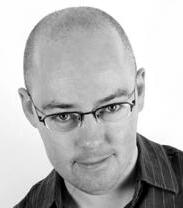

John Boyne, author of the much discussed, international best seller, “The Boy in the Striped Pajamas”, explains how he came to write his book with a very different slant on the Holocaust, in a frank interview with Centre News Editor, Stan Marks. The book is also reviewed, including by Jewish and non-Jewish teenagers, a University lecturer and comments by survivor Kitia Altman.
THE INTERVIEW
Exactly which, if any particular age group, is the book aimed at? Is it for the young (how young?), teenagers, or all readers?
When I wrote the book and gave it to my agent to read, I presented it as a children’s novel and it’s true that children were my initial intended audience. However I hoped that adults would be interested in the book too and felt that there were levels within it that would be more accessible to adults than children.
Ultimately I hope it is a book that readers of all ages can read and be moved by.
Could it be read by families and discussed?
When younger readers come to the book I always hope that they will have parents or teachers nearby to discuss some of the more upsetting aspects of the story and who will be able to answer some of the questions that a novel like this inevitably raises.
What motivated you to write the book?
What I aimed to do was write a book for younger readers in a way that wouldn’t patronise them, wouldn’t speak down to them, wouldn’t flinch from the harsher realties of life but neither would I aim to shock or scare children. I suppose I wanted them to ask questions. I hoped that I might open a door just a little crack and leave them feeling unsettled and disturbed by the end of the book and want to either go to their library or bookshop or parent or teacher and start a conversation about a very important topic which everyone must learn about at some point but which, for the younger members of society in particularly, must be explored in a sensitive and careful way
For many years I had been a serious student of Holocaust related literature. Purely as a reader, and one with an interest in history, I had read many memoirs by survivors of the death camps and many nonfiction books related to that time. I had watched the documentaries and films but there was never an occasion, not a single one in my 20 years of writing before beginning this novel, that I ever considered writing a book set during this time myself. The truth is that the idea for this novel came to me one night as I was going to sleep in Dublin. An image came into my head of two little boys sitting on either side of a fence, having a conversation. I knew where that place was, I knew it was a setting where by rights, no one should ever have been. I was interested in the journey that would bring these two boys to that place, sitting across from each other, the conversations they would have, the things they would have in common, and the necessary end that they would reach.
Since publishing the book I have met many Holocaust survivors and been encouraged by their hugely positive response to the book. Did it have some special relevance for today that led you to write it?

In speaking about these subjects to children in schools during 2006 it’s become very clear to me that while they have a basic awareness of what took place under the Nazi regime during the Second World War, they have less knowledge of the fact that the world is not exactly a better place now than it was then. It won’t surprise many of you to know that they have no knowledge whatsoever of the atrocities which are less publicised in the world. I’ve spoken to them of the millions who died under the Pol Pot regime in Cambodia in the 1970s; of the genocides which have taken place in Kosovo, in Rwanda, in Srebrenica; of the conflicts which tore apart Northern Ireland from the 1970s to only recently; of the prejudices which led to apartheid in South Africa and how those fences were eventually torn down; of the continued hatreds around the world which give us events like 9/11, regimes like that of Saddam Hussein and Slobodan Milosevic, killers like Osama Bin Laden; we’ve spoken of what they understand by their own civil liberties and considered the fact that the world stands by and allows atrocities to take place under their own eyes. In my travels around schools the novel has
CENTRE’S OPENING HOURS
Monday, Wednesday: 10.00am – 4.00pm
Tuesday, Thursday, Friday: 10.00am – 2.00pm Sunday: 12.00am – 4.00pm
Admittance free

8
led them to ask questions about the world in which they live.
How long did you work on it?
From start to finish, a year.
Where there many drafts or final changes?
Many drafts along the way, about a dozen I suppose. Why isn't Auschwitz named or Hitler rather than Fury, when Eva Braun is named?
One of which was the question of how close to the true-life events of the Holocaust I wanted to get. I decided very early on that I did not want to write a novel specifically about Auschwitz or Dachau or any of the camps during that time; I wanted the camp that I created to represent the many death camps which the criminals created around Europe in the early 1940s. This is one of the reasons why the word ‘Auschwitz’ is never used in the book. The implication is there, of course, in one of Bruno’s mispronunciations, but an implication is all it is.
What was your aim in making the grandmother the questioning one?
In the personalities that filled the novel, I wanted to create realistic characters but also allow them to be metaphorical representations of certain ideologies that pervaded Germany at the time. Bruno’s grandfather was a soldier in the Great War, a man who like many others at the time believed that Germany had been unfairly dealt with at Versailles; his grandmother is the voice of reason, the one person who has the courage to stand up and protest at the activities of the Nazis in her land, a voice which is necessarily silenced as the novel continues. His mother, while more ambivalent about the activities in the camp, turns her head away and learns to ignore them; her status, her position in society is ultimately more important to her than the lives of the innocents. Gretel, Bruno’s older sister who begins the novel playing with dolls slowly turns away from them and papers the walls of her bedrooms with maps, placing pins in them to follow the advance of the German army across Europe, an interest which is sparked by nothing more than a teenage crush on a handsome young lieutenant.
My wife as a nine year old until the age of 15 spent six years in the Siberian Gulag, after being
REVIEWS AND COMMENTS
Bill and Patrick Anderson
Two non-fiction, Holocaust related books made a deep impression on the reviewers last year.
The first was "The Book Thief" by Markus Zusak and the second was "The Boy in the Striped Pyjamas". Both of these books can be seen as "children's books", both have also found an appreciative adult audience and both, despite telling apparently straightforward stories, are complex and demanding reading.
Another thing which ties these two books together is the way in which readers are generally polarised in their responses - you either love them or hate them,
forced to leave Vienna by the Nazis (aged 6). She wonders, as the same age as Shmuel and Bruno, whether they aren't naive and how they could, even in childish innocence, act as they did?
I feel that such an argument is taken with the knowledge and hindsight of history. I think that a sheltered nine year-old boy does not question what is taking place around him but simply accepts it and selfishly wonders whether it’s a good place or a bad place for him to be. How is it that with electrified fences and so on, and guards ever watchful, the two boys could meet and stay together as they did?
Because it is a fable, not a real story from a real camp. The word fable is on the title page. The emotional integrity of the book was the most important thing to me.
I realise it is a fable, but for nine year olds, as in the book, especially for Bruno not to have some inkling of what was going on (why the starvation, etc?) seems to lack reality and truth. My wife says she realises a fable is a make believe story but wonders - If the book is meant to give an insight into the Holocaust, even to give a wish to know more about it, does it really (indeed, is it meant to) open a door to what really happened in these camps?
That’s really a question for readers to answer but I feel that the fact that the book has been read and discussed by so many schools, opening a debate about children’s literature and the Holocaust, achieves a result in itself.
Is it being considered for a film?
Yes, it is being made my Miramax/Disney, producer David Heyman (Harry Potter) and director Mark Herman (Little Voice). It will start shooting in Eastern Europe soon.
John Boyne was born in Ireland in 1971 and studied at Trinity College, Dublin, and the University of East Anglia, Norwich. He is the author of the novels, “The Thief of Time”, “The Congress of Rough Riders” and “Crippen”. He lives in Dublin.

there seems to be little middle ground - and we suspect that those who love one will love the other and those who dislike one will dislike the other.
For reasons which will become obvious to those who read this book, it is important that reviewers do not "give away" too much of the story but the core of the book is the friendship that develops between a German boy called Bruno, the nine year old son of the Commandant at a concentration camp called "OutWith" (Auschwitz) - a man important enough to have "Fury" (the Fuhrer) to his house for dinner - and Shmuel a Jewish boy of the same age who is a prisoner in "OutWith" with all the deprivations, dangers and horror that this implies.
The two boys bond, particularly after they discover that they share the same birthday, and they discuss many
9
Bill Anderson
things during their conversations through the barbed wire of the camp, including descriptions about the cities they came from, their life before the war and the living conditions in the camp. Bruno has great difficulty in understanding Shmuel's description of conditions within the camp, how could he comprehend that his beloved father was directly responsible for the barbarism that Shmuel describes behind the barbed wire? How could a child - any childcomprehend such monstrous evil, a man-made tragedy on such a vast scale?
Some reviewers have challenged the historical plausibility or even possibility of a friendship such as the one in the book between Bruno and Shmuel. In fairness to the author we would note that the book is a novel and that it is subtitled as "A Fable". In reference to the historical plausibilty of the story, we would further note that contacts between prisoners and the families of camp personnel were by no means impossible.
“The Boy in the Striped Pyjamas” was initially

TEENAGERS’ VIEWS
Lucie Harris 15
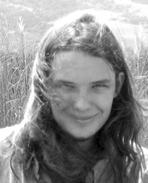
I had mixed feelings while reading this book. I found it to be an interesting and different view of the Holocaust, and an insight into what may have been understood by a child at that period. I found the story at times as being possibly upsetting to the Jewish community, especially Holocaust survivors.
Then again I endeavoured to understand the reality that you can try and eradicate as many races as you can for as many reasons, but in the end, you are left with the fact that fear and ignorance are never an excuse. No matter whatever your view of changing the world may be, genocide will never be an answer.
Bruno endeavours to strike up a friendship with Shmuel, a boy of his own age, who is a prisoner in the camp. They meet regularly and become firm friends, despite the camp’s wired fence. They are of the same age, but of very different worlds.
In a very simple form of writing, the cruelty in parts of the book disgusted me. To Bruno, it is life.
Watching the German soldiers laughing as they inflict pain and punishment on the people behind the wired fence seemed to Bruno to be quite normal. He does not understand any part of what is really happening. Why he is forbidden to visit the camp and make contact with those inside is strange, but he accepts it. He imagines different reasons why the people are behind the fence. They have frail faces, frail bodies and wear strange clothes, like striped pyjamas. But, Bruno cannot find answers, and is left with his own imagination.
I recommend this book. It will give you a thoughtful and different view of one of history’s largest mass murders.
targetted at nine to twelve year olds, it is a very short book and although a little confusing at the start - and probably very confusing for anyone who doesn't have a basic knowledge of World War Two and the Holocaust - it is well-written, engaging and builds towards a very moving and powerful conclusion.
Although there is no explicit violence in the book there is an underlying sense of threat, a pervading darkness and a tragic dimension to the story. It is a book that is very confronting and potentially disturbing and I would suggest that while it has great value for children and young adults it would be wise to ensure that they have support, guidance and a chance to talk about the book while they are reading it. This is a book that has a high moral purpose and it is potentially very rewarding reading for children and young adults but there is no gainsaying the fact that it is challenging both intellectually and emotionally. Ideally this is a book that should be read and discussed within the family circle or in the classroom and it is a book that can be strongly commended to adults as well as children. Bill Anderson is a University lecturer.
Benjamin Lipson 16
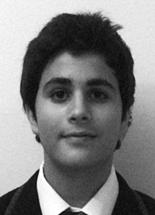
“The Boy in the Striped Pyjamas,” written by Irish author John Boyne in 2006, is a fable set in Germany and Poland during the Holocaust in the Second World War.
From the outset of the book, we find that due to Bruno’s father’s work, the family has to leave Berlin for an unknown location for the foreseeable future. The reader later finds out that the family has been moved to Auschwitz to oversee operations at the camp. Bruno, a natural explorer, is disappointed with the new house and eventually decides to explore away from the house and along the camp fence, after being told not to.
After travelling along the fence he meets ‘the boy in the striped pyjamas,’ a Jewish boy named Shmuel who is exactly the same age as he. The narrative then follows Bruno as he strives to meet Shmuel and converse with him every day. Bruno does this because he wants a friend and because he wants to defy his parents and explore. As the two develop a bond, Bruno is still painfully unaware of the likely fate of his friend.
At least an attempt has been made by the author to accurately portray the impressions an innocent little boy might have. Ironically this was where I found the main problem with the book.
While Bruno is understandably naïve and unaware (as he is a young child), as the book progresses the character comes to no realization about the gravity of the situation. While Bruno doesn’t actually do anything wrong, it might’ve made more sense in terms of character development if he had come to a realisation abut what he was involved in. Bruno’s motivations seem slightly lacking because he doesn’t specifically seek out Shmuel because he is Jewish and he wants to defy his
10
Patrick Anderson.
Lucie Harris
Benjamin Lipson
father’s and Hitler’s evil regime rather because he had his own childish motivations for doing so.
The reader who has a knowledge of history, can understand the situation. Because of this Bruno’s journey almost seems pointless in the end. A counterpoint to my argument could be that Bruno was still a young child and could never be expected to understand and be expected to come to terms with the situation as an adult might have. Although he represents the innocence of youth, I am sure that Shmuel, Bruno’s counterpart within the camp, would have had a basic understanding of what was happening.
The book does not provide very detailed information about the Holocaust and glosses over some very important aspects, but it would still be a good
SURVIVOR’S VIEW
Kitia Altman, Survivor
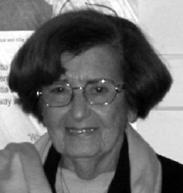
I found it more than a bit annoying to read “The Boy in the Striped Pyjamas”.
For many youngsters and some adults, this book may be the first (and only) encounter with the idea of a total annihilation of a race of people, and of the concept of superiority of one group of people over another with ultimate murder.
A young, sensitive German boy living with his family not very far from the barbed wire compound of bizarre looking people – does not know what is the real purpose of the camp where his father works? While the plot irritated me its messages alarmed me. Sometimes uniformity of dress is not always egalitarian, like a school uniform or sport’s outfit, other times, it mirrors an anti-
introductory point for parents wishing to teach their children about the Holocaust and the truth of what really happened.
In the end, “The Boy in the Striped Pyjamas” imparts a number of important messages including that following leaders is dangerous, things should be queried and, in an ironic ending, that history can repeat itself, which are messages all children can take something from.
It is a shame however that the limitations of its protagonists’ development stop it from becoming an essential read. In spite of that flaw this is still a fine read for adults and children as it is fairly well written, poignant in parts and uses metaphors and puns in an interesting way to portray the Holocaust from the point of view of a child.
social behaviour, as in prison. Unfortunately in camps it was an expression of dehumanization suppressing human identity.
The innocent, good-hearted German boy fell victim to his friendliness with a Jewish boy, who lived behind the (not electrified) barbed wire. Why? Whose victim was he? What did the German boy want to achieve by joining his Jewish friend? Identification with the persecuted or “good deeds don’t pay?” Or perhaps to show, that at the end, the good (the German boy) and the bad (Jewish boy), regardless who they are, share the same fate.
Whatever it may be, is this the proper message to send to readers, who, as it is live in a world of violence and brutality – a message of gloom and doom?
This is not a story of milk of human kindness flowing from the heard of a good, innocent boy; neither is it a story of an attempt to help a victim of injustice and paying for it with his own life.
Don’t miss the chance to become a ‘Partner in Remembrance’ through the Jewish Holocaust Centre Foundation. Join with Steven Spielberg, one of the Foundation’s Patrons, and ensure the on-going success of the JHC.
Three levels are available and are payable over five years.
All donations are fully tax deductible
Gold Partner $18,000
Silver Partner $10,000
Bronze Partner $ 5,000
Each ‘Partner in Remembrance’ will be acknowledged.
Further details available from Helen Mahemoff, Chair of the Foundation
9822 8080 or 0417 323 595
11
Kitia Altman, Centre Guide
MY FIRST YEAR AS CENTRE’S CO-PRESIDENT
Pauline Rockman, Co-President of the Jewish Holocaust Centre

It is almost 12 months since I became co–president of the Jewish Holocaust Centre. As I look back I find much to reflect upon. Indeed, it has been a most challenging, jam packed and inspiring time.
I wanted to write about my initial involvement with the JHC, the path leading to where I am today, as Co- President as well as my vision for the Centre.
I recall the early 90s and my entrée into this venerable institution. At the time I was working as a counsellor in private practice and also as an Outreach worker in Cranbourne in the area of Family violencethis sheltered woman from our “shtetl by the Yarra,” who grew up in post-Holocaust Melbourne, daughter of a refugee/survivor from Nazi Germany, surrounded by survivors and many unspoken tales of horror about the Shoah, experienced the worst life crises of a client to the point where I decided to take some time off from that work.
A short time later I saw an advertisement in the Jewish News seeking people to interview Holocaust survivors at the Jewish Holocaust Centre.
I ran to it, embraced it, so commencing an odyssey of the most meaningful work of my lifetime. My entrée was via the testimonies department where I spent nearly two years interviewing Holocaust survivors. I had an impressive apprenticeship working alongside Phillip Maisels, departmental head.
It was an extraordinarily humbling and uplifting experience, hearing about the Shoah from the actual eyewitnesses, those who were actually there. This became the catalyst to learn more about the Shoah, leading me to studies at Yad Vashem, and my work as Regional Co-ordinator of the Shoah Foundation and to a greater level of involvement at the Centre.
Today at the Centre we are moving into a new phase, as the 21st century unfolds, to ensure our continuation. There will be challenges ahead but at the heart of it remains the survivors and what they have
endowed us. It was they who created and staffed this museum in its first 20 years.
I am overwhelmed by their capacity to pass on the legacy by not preaching hatred. I am optimistic and determined that their legacy will continue, however it is up to all of us to work towards this.
I cherish my weekly meetings with the founders of the Centre. I appreciate their input, their willingness to impart their wisdom and their actions in passing the baton to my generation to ensure our Centre’s continuation. I love the interaction I have with the survivors as I walk through the Centre.
As I enter each department, I am greeted with much positive feedback and encouragement “oh good afternoon Madame la presidente” - affectionate banter underlying what I perceive as a deep sense of having been entrusted with their precious gift, the legacy for future generations. Working alongside a dynamic team of people at the Centre is also a positive and growing experience.
I dream of a Centre that provides a unique and provocative experience that challenges visitors to become witnesses to history, to confront the dynamic of hatred and mistrust of the other that is relevant in today’s society. The Holocaust is not in the past, it is the present; the elements that made it possible are with us today, and all civilized societies have to be reminded of the dangers.
We do not have to look too far, the events in Darfur are a testament to this. I see the current upgrade of our museum as moving well in this direction.
I fully endorse the philosophies of the JHC’s education program including that the Shoah should never be reduced to the status of a footnote to the Second World War. It cannot be explained away by a one dimensional theory that it is just an extreme example of human prejudice.
I want the 3rd generation, the next generation to be involved at the JHC. Their honesty and vitality is breath of fresh air and brings with it a great hope for the future. As my generation and the survivors have interacted and have had issues that we worked on constantly so it must be for the next, if we are to continue our work le dor vador, from generation to generation!
CONSIDER A BEQUEST TO THE CENTRE

Copies of a brochure explaining how to make a bequest to the Centre are available. After making provision for your families and other considerations, you may consider joining the increasing number of people who have, or are, considering providing small and large bequests in their wills to the Centre. This is a lasting acknowledgment of the Centre's work.
For further information call Elly Brooks Bequests Officer at 9528 1985.
12
Pauline Rockman
WHAT TESTIMONIES REVEAL
Phillip Maisel said: Our collection of 1,300 video testimonies is of immense importance. The testimonies reveal the feelings and emotions of people who directly faced the traumatic events of the Holocaust confirming these events as seen by direct eye witnesses.
Their testimonies express the human experiences of the Holocaust in a form that is personal and direct and allows the viewer to understand the impact on individuals of this historical event in a most powerful way. The objective of the Testimonies Department has always been to make the knowledge contained in the testimonies widely available to researchers and the general public.
The Linkage Project has brought this closer by
enabling the video testimony collection to be broadly accessed and it has assisted the Jewish Holocaust Centre in spreading its core message. The project has contributed to analysing more clearly and systematically where intolerance and fanaticism can lead. This is particularly important today in the context of increasing tensions between different religions and cultures across the world.
The urgency of Survivors to give a personal testimony could never be underestimated. It is acutely imperative for Holocaust Survivors who have not yet done so to ensure that their experiences are recorded so that their voices continue to be heard. If you would like to give testimony, please contact Phillip Maisel, phone: 9528 1985 or 9527 6282 (AH).
SUCCESSFUL PROJECT WITH DEAKIN UNIVERSITY
Phillip Maisel (Head of Testimonies Department)
The Linkage Project commenced in 2003 between the JHC and Deakin University has been successfully completed.
The project which received $138,198.00 in Federal Government funding, aimed at analysing our collection of Testimonies of Holocaust Survivors. The main participant was Dr Michelle Langfield from Deakin University, Burwood. Other participants were Pam McLean from Deakin University, Geelong and Dr Peter Monteath from Flinders University in South Australia. Research Assistants were Donna Freeze and Janette Sato.
As part of this project, Phillip Maisel and The Holocaust Centre sponsored a scholarship for Amelia Klein who successfully completed her Masters Degree this year in Holocaust studies. The report the project made significant advances in the area of Holocaust interpretation.
It is the first systematic project based on the Jewish Holocaust Centre’s video testimonies. It looked at the role and significance of the video testimony as a primary source for the transference of memory and as legacy. It contributed to creation of new perspectives to understanding backgrounds of a group of Australian immigrants immediately before and after WWII.
It indicated how trauma continues to influence people’s lives decades after it was first experienced. It has revealed notions of Survivor guilt and looked at the impact of class, gender, religious, cultural and national identity bring to the study of memory.
NUMEROUS BENEFITS
There have been numerous benefits of this research to the JHC specifically and the wider community generally. It has enabled the video testimony collection to be widely accessed. The researchers have brought greater insights and different interpretations to the collection broadening its relevance. It has greatly assisted the JHC in spreading its core message. The knowledge is relevant for the whole of humankind. The outcomes have illuminated more clearly and systematically where intolerance and fanaticism can lead. The methodology developed in this project has the potential to be widely applied by researchers of video testimonies.
The project has led to greater public understanding of the Holocaust and it has heightened awareness of the consequences of racial prejudice. It has contributed to an understanding of the origins of Australian refugee policy.
Research of the tapes led to a series of papers to be delivered by participants of the project at national and international conferences and symposiums.
The number of undergraduates, Honours and Masters Students researching the Testimonies at the Holocaust Centre increased dramatically due to the cooperation with the universities involved in the Linkage Project.
The project has been mutually beneficial and meetings are underway for a second Linkage project this year between Deakin and JHC.
13
DISCLAIMER: The opinions expressed in Centre News are those of the authors and do not necessarily reflect those of the magazine's editor or editorial committee. While the Centre News welcomes ideas, articles, photos, poetry, and letters, it reserves the right to accept or reject material. There is no automatic acceptance of submissions.
OVERSEAS STUDENTS STUDY AT CENTRE
We received a complimentary letter from Professor Don Gibb Honorary Associate, Faculty of Arts from Deakin University, Melbourne campus thanking us for assisting Youshi Asakura with his research. He said the program completely depends on willing supervisors and his experience with us was very valuable to both Youshi and to the University. In 2007 Monica Cronin will resume her studies into the life of Jewish refugees who fled to Shanghai and will be utilising the resources of the Testimonies Department.
Phillip Maisel with Yoishi Asakura (left) from Japan and Joel Anders (right) from America, at the Centre. The boys studied the making, recording and use of testimonies at the Centre. Both boys described their experiences at giving them a much deeper insight into and understanding of the Holocaust and Survivors. More than 1,250 testimonies have been recorded at the Centre.
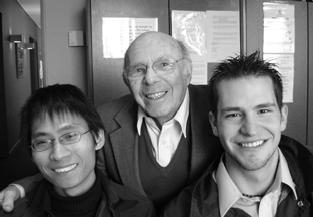
NEW ZEALAND REQUEST
The Auckland University Language Department has asked the Centre's Testimonies Department, to help them start a Holocaust Testimonies project.
Mr. Maisel said this would be based on the Centre's internationally acclaimed, highly-successful Testimonies Program. The New Zealand Jewish community (approximately 5,000) differs from the Australian community comprising mainly refugees who arrived before WW11.
USA STAMP RECOGNISES JEWISH SAVIOUR
An American postage stamp recognizes the work of Harry Bingham who saved 2,500 Jews during WWII.

City of Machu Picchu, Peru, in 1911. Harry entered the US diplomatic service and, in 1939, was posted to Marseilles, France, as American Vice-Consul.
Who was he and how did he save the Jews?
It is a fascinating story, and indicates the bravery of those who saved Jews at the risk of their careers and lives, including those now living in Australia, and honoured by the Centre.
The American Government gave a posthumous award for “constructive dissent” to Hiram (Harry) Bingham, IV. For many years the State Department would not honour him, but after his death his work has been acknowledged and he has become a hero.
Bingham came from an renowned family. His father (on whom the fictional character Indiana Jones was based) was the archeologist who unearthed the Inca
THE MEANING OF GENOCIDE
Many readers have asked how the word genocide came into being.
Raphael Lemkin, a Jewish refugee who fled Poland to the United States, introduced the term genocide in 1944 to describe what was happening in Nazi-occupied Europe. In 1948, the United Nations adopted the UN Genocide Convention, which defined genocide as certain acts undertaken with the intent to destroy, in whole or in substantial part, a national, ethnic, racial, or religious
In defiance of his bosses in Washington, he granted over 2,500 USA visas to Jewish and other refugees, including the artists Marc Chagall and Max Ernst and the family of the writer Thomas Mann. He also sheltered Jews in his Marseilles home, and obtained forged identity papers to help Jews in their dangerous journeys across Europe.
He worked with the French underground to smuggle Jews out of France into Franco's Spain or across the Mediterranean and even contributed to their expenses out of his own pocket. In 1941, he was sent to Argentina, where later he continued by reporting on the movements of Nazi war criminals.
He was forced out of the American diplomatic service and died almost penniless in 1988. Little was known of his amazing activities until his son found some letters in his belongings after his death. He has been honored by many groups and organizations, including the United Nations and Israel.
group, as such. In agreeing to the Genocide Convention, nations promised to “undertake to prevent” genocide.
If you have any queries about the Holocaust, Nazi era or allied matters, or have an opinion, write us a letter. We will appreciate receiving your letters and endeavour to answer your queries. And remember, while we consider all letters, publication is not guaranteed.
14
HOLOCAUST CENTRES AND THEIR MESSAGE
Distinguished Professor Yehuda Bauer doesn’t mince words in his lectures in Australia or anywhere else. You may not always agree with him, but as large audiences at the Holocaust Centre heard in March, he gave them much to think about and especially about the word ‘genocide’ and the future of Holocaust Centres –what must be their messages. He also spoke about “Why The Jews?”
A renowned writer and recipient of the Israel Prize for distinguished work, Professor Bauer was described by the Washington Post as the pre-eminent student of Jewish resistance and rescue efforts. The Post added that Bauer’s book “Rethinking the Holocaust, also reaches beyond issues of the rescue, offering a strong introduction to many of the analytic debates on Nazi genocide.”
Professor Bauer, when once asked wither he was an optimist or a pessimist replied “I am a historian”.
Speaking in Melbourne of the importance of Holocaust Museums, he said they should let the nonJewish world know what really happened – the non-Jews would remember.
He asked what would happen when the survivor guides at Holocaust Centres could no longer carry on their important work and were no longer around to relate their very personal experiences, especially to young people. What would they hear and see and discover?
There was an increasing need for others to take over and keep alive the Holocaust’s message. The next generations of survivors’ families, including the third generation. There was need for testimonies, videos and the modern communications.
He stressed that the Australian Jewish population per capita was growing, and it was up to the local Jewish people to let non-Jews here know about the Holocaust. The Melbourne Centre had to ensure they were aware of the symbolic nature of the Holocaust. In many countries, non-Jews knew very little about the Holocaust.
He stressed the urgent need for Holocaust Centres worldwide not only keep alive the message of the Holocaust, but of current genocides.
“Who comes to your Holocaust Centre?” Professor Bauer asked. “About 15 to 16,000 students annually. This was good, but after a couple of hours at the Centre, it was all about the next cricket game or something else. A Centre visit was just the start.”
“You must involve the adult public – think broadly. Widely. There is an increasing globalization of the Holocaust, horizontally and vertically. The whole history, culture, politics, many things.”
Professor Bauer told the Holocaust Centre audience that the Holocaust was different from other genocides because the plan was to annihilate all Jews. It was the most extreme kind of genocide – a precedent. And it could happen again. The problem was humans and what humans could do.
He insisted, that there were other genocides, such as Darfur. People lost their families, their homes and were
left with no-one, nothing and nowhere to go. It was not a matter of any comparison, but genocide was genocide.
He mentioned that in Washington there was a Committee of Conscience to deal now with genocide, such as in Darfur.
Professor Bauer said that Holocaust denial was now marginal in the west, and he did not talk to deniers. But there was strong denial movements in some areas.
Professor Bauer also reiterated in Melbourne some of his questions and comment he raised in his address to the First Universal Commemoration in Memory of Holocaust Victims, held by the United Nations last year. He described the commemoration as symbolic.
He said, of course, there are parallels between the Holocaust and other genocides. The main was the suffering of the victims was the same. Murder is murder, child murder is child murder, torture was torture, rape was rape; starvation, disease, and humiliation are the same in all mass murders.
He said there are no gradations, and no genocide is better or worse than another one, no one is more victim than anyone else.
“Nazi Germany used a modern bureaucracy and the best technological means at their disposal. The Hutus and the Janjaweed did not and do not have gas; the Germans did, so they used it. Yes, it is true that the Holocaust was perpetrated at the very centre of some of the European and world civilization, and that the main perpetrators came from the same places from which some of the most wonderful cultural achievements of the human race had originated. The German people had produced Kant and Hegel, Mozart, Beethoven and Brahms, Dürer and Planck; unfortunately, these were not the names of the people who ran Germany in the thirties and forties.”
“The fact of this tragedy happening at the centre of supposedly advanced civilization was unprecedented. But the fact that it was done with the best available technical means at the disposal of the perpetrators, that is paralleled in other genocides.”
“Political scientists have shown that during the twentieth century vast numbers of civilians and unarmed prisoners of war were murdered by governments and political organizations – some say 91 million people, others say more than that. In addition, some 34 million soldiers died in all the wars of that period, including the two world wars.”
“That means that many more civilians than soldiers were killed. Of these, close to six million Jews died in the most extreme case of genocide so far. Why is the Holocaust the most extreme case? Why do more and more people show an interest in this particular tragedy, why is there a flood, theatre, films, TV series, art, music, and of course historical, sociological.”
“Political scientists have shown that during the twentieth century vast numbers of civilians and unarmed prisoners of war were murdered by governments and political organizations – some say 91 million people, others say more than that. In addition, some 34 million soldiers died in all the wars of that period, including the two world wars.
15
“That means that many more civilians than soldiers were killed. Of these, close to six million Jews died in the most extreme case of genocide so far. Why is the Holocaust the most extreme case? Why do more and more people show an interest in this particular tragedy, who is there a flood of fiction, theatre, films, TV series, art, music, and of course historical, sociological, ???
HOLOCAUST UNPRECEDENTED
“We had hoped that the Holocaust would become a warning, not a precedent. It has become a precedent, and other genocides have followed it. What does this mean for humanity, what does it mean for the United Nations? What shall we do about the United Nations?
“The UN is ours; it is the best UN we have – we have no other. So, rather than run it down, rather than criticize it out of existence, let us support it, try to improve it, make it more effective in protecting humanity.
“Is there any possibility that we may succeed when we try to prevent genocides, using our understanding of the paradigmatic genocide of the Jews, and the comparison with other genocides that must follow from that? Is the propensity to murder and murder massively something that we all somehow have within us? I do think that humans have in them the instinct to kill, whether individuals or groups, and we are the only mammals that kill our own kind in huge numbers.
“This may well be the result of the development of our species, when we defend ourselves, our families, clans, tribes, nations, and territory from real or imagined enemies by eliminating them. If we did not have that instinct within us, how then can we explain the fact that practically all societies have laws against murder? If we were not inclined to murder, these laws would be totally superfluous. Given different upbringings and socialization processes, and a different history of our communities, we all could become mass murderers. But if that is so, is there any realistic way of preventing outbreaks of genocidal murders?
“The Holocaust is one of the genocides that provide an answer to this question: at Yad Vashem, the Israeli
and Jewish Institute for the Commemoration of the Holocaust, we now have over 21,000 names of individuals and groups that rescued Jews, and I think that the real number may be at least ten times higher – we just don’t know the other nine tenths. They may be only a small proportion of the European populations that might have rescued their fellow humans, but did not, but they show that there is an alternative, that there is in us also the possibility of coming to the rescue of other humans at the risk of their own lives.
HUMAN DEPRAVITY
“Certainly, the Holocaust shows the depth of human depravity; but on its margins, there are the peaks of human self-sacrifice for others. It is that that shows us that there is an alternative, that the attempt made at prevention of genocides, as for instance by the office of the Special Adviser for Genocide Prevention of the Secretary-General, and by various NGOs and governments, are not a hopeless task.
“We are all one human race, interconnected and interdependent. Politics that are not based on moral considerations are, at the end of the day, not practical politics at all. It is out of these considerations that I beg you to permit me to repeat here what I said in a speech to the German Bundestag: I come from a people that gave the Ten Commandments to the world. Let us agree that we need three more commandments, and they are these: though shalt not be a perpetrator; thou shalt not be a victim; and thou shalt never, but never, be a bystander.”
Many people asked questions during and after the Melbourne lecture. They included about genocides past and present, incidents in the Holocaust and, above all, how such Centres as in Melbourne could ensure the message of the Holocaust got across to all people.
Where the right speakers, functions and events being held that would hammer home the vital messages for today out of the Holocaust. How did bringing different ethnic groups together help? Above all, are we learning from the past? Questions for individuals and people at the worldwide Holocaust Centres to ponder.
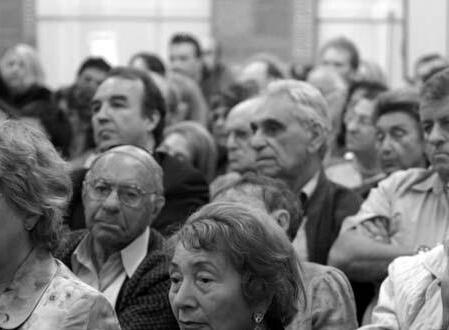
If you would like details about sponsoring or advertising in an issue of Centre News, contact Stan Marks on 9528 1985.
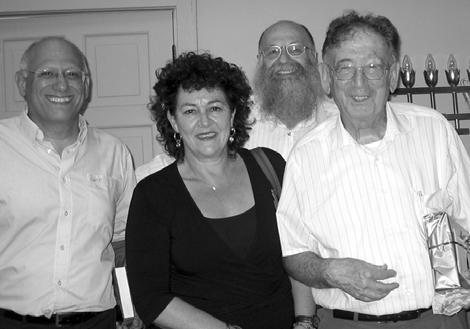
16
Audience at one of the Yehuda Bauer lectures.
Professor Andrew Markus, Pauline Rockman, Bernard Korbman and Professor Yehuda Bauer
WHO WAS DIETRICH BONHOEFFER?
Rabbi John Levi
A few days after Kevin Rudd became parliamentary leader of the Opposition he mentioned that his spiritual hero was a German Protestant theologian named Dietrich Bonhoeffer, a courageous opponent and victim of the Nazis.
Bonhoeffer was born in Breslau in 1906. His mother, a university graduate, was the daughter of a world renowned historian and his father was senior physician in charge of Neurology and Psychiatry at Berlin’s major hospital. Bonhoeffer attended one of Berlin’s most eminent High School where one of his Jewish classmates was Grisha Sklovsky who later became the architect of SBS in Australia.
The young Dietrich astonished his very secular family by deciding to become a pastor. He studied theology at Tubingen University and then Berlin. A gifted academic and a prolific writer and broadcaster Bonhoeffer travelled to North America to study at the Union Theological Seminary in New York. In 1931 he returned to Berlin. Two days after Hitler’s rise to power he spoke on radio expressing his strong opposition to the new dictatorship. He warned his listeners about the danger of giving their souls over to man who demanded their total obedience. The broadcast was abruptly terminated before he could finish the last sentences of his text.
Inevitably the German Protestant Church in Germany split in two very unequal parts. The “confessing” church believed there could be only one Fuehrer and that leader was not named Adolf Hitler. Sadly, to their everlasting shame, the vast majority of theologians supported the national church of Deutsche Christen which followed the National Socialist ideology and even advocated removing the Hebrew books of the Bible from the canon.
CHURCH AND NON-ARYANS
By mid July 1933 it was proposed that non Aryans could not serve as ministers of the Church or as religious teachers. The German Evangelical Church debated the issue and which Bonhoeffer bitterly opposed on the grounds that the state was attempting to interfere with the mission of the church. When the measure was actually passed Bonhoeffer appealed to the international section of the Church to repudiate it. In July 1935 Bonhoeffer became the principal lecturer at the clandestine seminary at Finkenwald near Berlin. It was created because all existing theological university faculties betrayed their ideals. Bonhoeffer bitterly commented “I have long ceased to believe in the universities”.
Two years later the Nazis closed the seminary and Bonhoeffer refused a call to return to America and to leave Germany. At the time he considered himself to be a pacifist and a follower of Mahatma Ghandi but events overtook him. Bonhoeffer was a radical theologian who
has been described as “a practical atheist and a religious humanist who denied virtually every cardinal doctrine of the historic Christian faith”.
A great deal of his radical theological approach hardly impinges on Jews. He believed it was impossible to know the objective truth about the real nature of and essence of God and paradoxically wrote “God as a working hypothesis in morals, politics and science… should be dropped or, as far as possible eliminated”. A religious believer could be identified not by belief but by the ability to experience the pain of other individuals and suffering in the world.
JEWISH QUESTION
In April 1933 following the officially sanctioned “Boycott Day” Bonhoeffer wrote an essay on “the Church and the Jewish Question”. By implication he accepted the prevailing theories that the Jews were a race apart. His Lutheran heritage of obedience to the state ran deep. Christianity, he believed, had superseded Judaism and the Jews would cease to be punished by God when they “saw the light”. As he wrote “The history of the suffering of this people, loved and punished by God stands under the sign of the final homecoming of the people of Israel to God. And this homecoming happens in the conversion of Israel to Christ.”
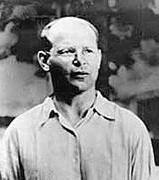
He wrote that Christians had the duty to help “the victims who have fallen under the wheel, but to fall into the spokes of the wheel itself”. In that same month Bonhoeffer was asked to officiate at the funeral of a Jew whose father had married a convert to Christianity. Bonhoeffer refused the request but later apologised to the family “How could I have been so terribly afraid? I must ask you for forgiveness. Today I know for certain that I should have done otherwise.”
The issue of the status of Jews who had converted to Christianity became a central issue for the members of the Confessing Church. When the synagogues of Germany burned on 9 November 1938 Bonhoeffer wrote in the margins of his Bible next to Psalm 74 verse 8 “O God how long is the foe to scoff? How long will the enemy revile your name?” First he had defended “his” Jews. Now he fought for all Jews and began to write of the Church and Synagogue as “children of the covenant”. His personal journey had brought him a long way although he would never outlive his belief that conversion to Christianity was the highest spiritual goal for all people.
Bonhoeffer believed that his country’s moral collapse would bring upon Germany the wrath of God. By 1940 his writing and preaching was declared to be illegal. Incredibly, despite this ban and his very open political stance, his influential brother-in-law Hans von Dohnanyi managed to have Dietrich appointed to the Armed Forces High Command, Military Intelligence led by Admiral Wilhelm Canaris. Through this façade Bonhoeffer was able to keep in touch with his extensive contacts in England, America and in May 1942 was able to travel to Sweden to explore the possibility of a
17
Bonhoeffer in the courtyard of Tegel prison (summer 1944).
negotiated peace settlement. The Allies demand for Germany’s total surrender doomed his mission and inevitably the Gestapo learned of the military’s attempt to save what they could of their country.

In April 1943 the supporters of the negotiated settlement were imprisoned and in April of 1945 further links were revealed between Bonhoeffer and the group who attempted to assassinate Hitler in July 1944. As the Soviet Army drew near to Berlin Bonhoeffer was sent to the extermination camp Flossenburg in the Bavarian forest and on 9 April 1945 he was hanged.
It was a mere three weeks before the American Army liberated the camp. By the time the war ended four members of the family had been executed by the Nazis. Dietrich and his brother Klaus and two brothers in law Hans von Dohnanyi and Rudiger Schleicher.


Dietrich Bonhoeffer was a victim of his own conscience. He could have followed the vast majority of German Christian theologians and simply enjoyed a quiet and comfortable career in academia. As a young man he had worked in Spain, America and England. He could have simply abandoned Germany to its fate. He chose not to take the easy road. He knew that the king was naked and he said so. He gradually understood that he had to defy a political system that knew no mercy and he died a martyr. He has been called a flawed saint but he is a challenging role model to be adopted by any politician.
* Google contains a rich and contradictory source for the story of Dietrich Bonhoeffer. See also A Thread of Gold-Journeys toward Reconciliation by Rabbi H Friedlander, SCM Press, 1989.
IMAGES SPEAK IN DOCUMENTARY
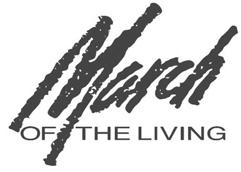
Yael Codron & George Halasz
In early 2006, I watched what I thought would be another ‘home movie’ at the home of Lindy Tamir for maybe 40 participants of the Adult March of the Living 2005. I recognized something easy to overlook – fleeting images with a primal resonance. The images and sound captured telling private gestures, intense moments shattered in a look, a resonant sigh as father, Bernie Hammersfeld and daughter Lindy, revisited Poland intrigued me. I needed to follow up.


Yael Codron’s rendered visual harmony exploded the limits of the viewer’s empathy, revealing a new vantage point to appreciate the unworded interior rhythms trauma disrupts at its core, traces of memory itself.
One year later, Yael and I were putting final touches to a video to celebrate my mother, Alice Halasz’s 80th birthday. We brainstormed a new documentary to explore the creative process of artist and distinguished photographer Emannuel Santos in his commissioned mural for the Jewish Holocaust Centre.
At this stage a brief digression to answer why another Holocaust focused documentary?
If future generations find a time capsule from our era they may ask why we were obsessed with the Holocaust. As we, a second and third generation descendants of Holocaust survivors, start our documentary, we also question if we are doing the right think to speak to survivors, yet again, about their experiences.

In the end is the beginning: our documentary start where Emmanuel Santos’ images stop. We explore two levels of an intimate relationship: first, Emmanuel’s artistic processes as he creates his mural; second, his subjects, survivors and descendants, reflect on the critical moments captured in the artist’s mural.
Emmanuel describes the inner workings of his art, how he decides to celebrate his vision, those chosen images that convey the essence of his story. His mural balances images as participants are immersed in their outer and inner traumascapes. What personal and family experiences inspired him to this creative art?
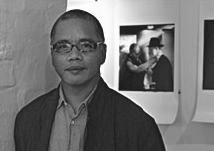
Turning to the participants, what motivated them to become share their intimate personal and family history, was it a moral imperative, a spiritual obligation or an act of commemoration of their personal loss amongst the lost generation?
During the preparation for our documentary, we delved into these and other questions, asked ourselves if as filmmakers we have a role to approach and render Holocaust images with a different reverence to other images.
As the photographed participants tell their story, to recall the feelings behind their fleeting glance, silent gesture or focused gaze, we were conscious how privileged we are to share with survivors their reflections on experiences ingrained for a lifetime, yet so delicate and fleeting in their recall.
What of the generations after? Will we remain conscious of our legacy, or will the past diffuse into the mist of history? The struggle to preserve an authentic past remains a generational challenge for each of us. Denial and myth’s antidote is the power images unleash to shatter ignorance, myth and prejudice. Some images in the mural seem to pulsate with the rhythm of trauma, decades after. Can pictures, more than words, breathe new life into traumatized survivors, descendants and witnesses.
Our documentary, located at our critical generational cross-road’s shifting consciousness is our personal commitment to our historical legacy through the medium of art, both the still and moving image.
18
DEATH OF TWO CENTRE VOLUNTEERS
VALE VOLUNTEER ARNOLD ERLANGER
22/7/1916 – 11/2/2007
Gary Fabian
Dedicated and much honoured and admired volunteer Arnold Erlanger died in February this year. Gary Fabian wrote the following obituary.
Zet, who had two daughters whose husband had perished in the Holocaust, and their friendship deepened, and they married in January 1947.
The urge to build a new life away from the shadows of Europe was strong, leading the family to emigrate to Australia in 1950, settling in Adelaide, where relatives had established themselves.
When Arnold Erlanger wrote his autobiography several years ago, he selected the title – Choose Life –and indeed the life he chose was a most extraordinary and impressive one.
He was born into a long established German Jewish family 22 July 1916, in Ichenhausen, a small town in Bavaria (Southern Germany).
The family lived a traditional Jewish life, were observant, but not extremely orthodox and celebrated all the traditional Yom Tovim.
In April 1937 he went on Haksharah in Halberstadt, in preparation for eventual emigration to Palestine if the situation of Jews under the Nazi regime worsened.
Arnold was incarcerated in the KZ Buchenwald, which was to mark the dawn of seven years of hell he would endure. After his early release from Buchenwald, he and his brother managed to leave for Holland in December 1939, where he joined another Haksharah. When his brother Gustav left for the USA in March 1940, he stayed in Holland, as his aim was to go to Palestine. After the German invasion of Holland in May 1940, life became more difficult, and in August 1942, he was interned, and in September 1943 deported to Auschwitz where he spent almost two years, finishing the war in Buchenwald and Floessenburg concentration camps, where he was liberated in April 1945, the Second day of Shavuot, a day that he always described as the second occasion of his birth.
Some weeks later he returned to Enschede in Holland and became an active member of the Jewish community, which he helped to re-establish. He met
Shortly after establishing a business, Arnold’s communal spirit led him to join several local community organizations, including Adelaide Hebrew Congregation, B’nai B’rith serving as vice-president of B’nai B’rith Australia/NZ for several terms, and the Chevra Kadisha, where he served as its president for 36 years. He helped establish the local Sunday school and kindergarten.
He moved to Melbourne and joined St. Kilda Hebrew Congregation, becoming one of its stalwarts who never missed a service when he was in town. Arnold also became very active at both the Jewish Museum and the Holocaust Research Centre, where he served as a guide, and in other communal endeavours.
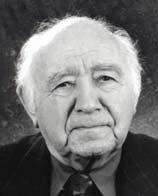
He wrote the story of his life in English, translated into German and published in Germany, a few years before the English version Choose Life, published locally through The Makor Library.
In 1989 he was awarded the Order of Australia (AM) for services to the Jewish community. His comment at the time illustrated his keen sense of humour “In Germany the government put me in a concentration camp, in Australia the government gives me an award for the same activity”. Zet died in 2005.
I met Arnold some 40 years ago through our association in B’nai B’rith, and renewed our friendship when he moved to Melbourne. His friendly greeting, his keen sense of humour, and kindness was always one of the pleasures on Shabbat morning in Shule, where he was appointed a life member.
He has been described by everyone who knew him as an extraordinary ordinary man, which is a very fitting one, but even more importantly he was a true mensch in every way.
His chair may be empty, but our memory of knowing Arnold, will stay with us for every. All of us who had the privilege of spending time with him, are left richer for the experience.
19
“Six million were wiped off the face of the earth. There is a danger that they will be annihilated from our memories. Are they doomed to a two-fold annihilation?”
Abraham Joshua Heschel
Two Holocaust Centre survivor volunteers Maly Kohn and Arnold Erlanger, died recently.
Arnold Erlanger
MALY KOHN GUIDES’ COORDINATOR
Maly Kohn, a volunteer at the Centre, since 1984 died in April. A most popular survivor, especially with young people, she was a coordinator of the guides and worked at the Centre up until the last few weeks.
in the past and could happen again if we did not alert them to possible dangers. Education in all its forms about the Holocaust was vital for all ages. We should also ensure all sections of the adult community knew about what could happen if we were not ever vigilant. “All sections of the community should visit the Centre and personally understand what occurred,” she said. “We must not let up on our work, never,” she added.
She was particularly interested in training volunteers to take over and keep alive the message of the Holocaust.
As a guide, she said she appreciated working with such a dedicated group of people, and felt all gained a great deal by giving students an understanding of World War 11. She stressed it was vital students, and, indeed, everyone learnt from the guides very personal experiences, even more important than ever these days.
Nothing was too much for Maly. She had a special vision for the Centre’s future and its importance as a place for combating all forms of racism and fostering understanding. A Centre (a heart) for understanding among all peoples. She insisted that the young, our future leaders, had to be educated into what happened
The Germans entered Maly’s town, Libau, Latvia, in 1941. Of the 10,000 Jews who lived there, 825 survived by the end of the year. From November Maly worked in the laundry of the Gestapo headquarters, cleaning bloodstains off officers’ clothing. In 1943, she was taken to Dundaga concentration camp.
Shmuel Rosenkranz, co-president of the Holocaust Centre, said Maly Kohn was an educator and one who passionately believed in educating young people, today's youngsters.
She was able to convey the message of the Holocaust to young and old, so that they could understand and grasp what had happened. She had a special way of relating the whole Holocaust event without exploiting it in any way. She was a dedicated volunteer. Maly Kohn will be very much missed.

HITLER, THE CULTURAL PLANNER
Bernard Korbman, Acting Executive Director
What has not been written about or has been dismissed as a minor almost caricature-like facet of Hitler’s life was his passion for art and an understanding of the arts.
spectators into participants in National Socialist theatre. Only Albert Speer, and Albert Speer’s editor Joachim Fest tough on the way Hitler was able to use his aesthetic talent in understanding that the fascist aesthetic itself reflected the needs and hopes of contemporary society.
Once in power, Hitler certainly became “the Art Dictator”. Hitler produced drawings of plans for galleries and exhibition spaces, as well personally meeting with artists and dictating the style of painting, sculpture and other art forms even cutlery.
The objects were manufacture at Gerdy Troost’s workshop (Hitler’s favourite artists/designer).
In his book, “Hitler and the Power of Aesthetics” Frederick Spotts postulates that once he had won his war and established an Aryan state that was a dominant world power, Hitler intended to devote himself to the creation of cultural monuments that would change the face of Germany and immortalize himself. Destruction was to be the way to construction.
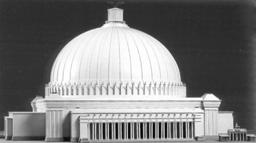
Hitler’s understanding of aesthetics also helps to explain his grip on the German masses. Using a then “modern” style of politics, mediated through symbols, myths, rites, spectacles and personal dramatics, he reached the masses as no other leader of his time. Though he took away democratic government, he gave Germans what they clearly found a more meaningful sense of political participation, transforming them from
Hitler took a keen interest in design and technology and was closely linked with the development of the autobahn and the development of the Volkswagen
This book gives an interesting insight into a dictator who not only wanted to crate the most militarily powerful Reich ever, but who wanted to create the greatest culture state since ancient times. After being appointed chancellor in 1933 the first building he erected was not a monument to his own triumph –comparable to Mussolini’s Forum Mussolini or Franco’s Valle de los Caidos – but a massive art gallery.
Hitler used aesthetics to help achieve and maintain power. He saw culture as a supreme value in maintaining the Nazi ideology for the thousand year Reich. Tragically what he proved was that culture and barbarism and savagery can exist side by side.
20
Maly Kohn
Albert Speer model design for the Berlin Capital, Grosser Platz, Great Domed Hall , 1939.
PRIMO LEVI Maria Lewitt
As on any other Monday, I exchanged greetings with Shmuel Rosenkranz and Stan Marks. I mentioned how involved I¹ve been in rereading the works of Primo Levi after watching the superb acting of Anthony Sher as Primo Levi, based on Primo Levi¹s “If This Is A Man” in a London theatre production shown on ABC television.
established an experimental laboratory desperate to discover synthetic rubber for their war effort.
Only 24 Italian Jews out of 650 deported together with Primo Levi lived to be liberated in January 1945 by the Soviet Army. It took Primo Levi nine months of wandering through Poland, Ukraine, Belorussia, Rumania, Hungary, Austria before returning to his family in Turin.
“I am a normal man with a good memory who fell into a maelstrom and got out of it more by luck than by virtue...” Primo Levi.
Once at home he experienced the urge to write. He knew that he would have to do it to free himself from his memories. He finished “If This Was A Man” a few months after his return home. He said: “I write what I would never dare to say.”
The manuscript of “If This Was A Man” was rejected by a number of well known publishing houses. In 1947 a small publisher recognised the value of the book and printed 2.500 copies. The world was not ready to listen to what happened during the war.
I mentioned that as a guide and throughout my contact with teachers, students and private visitors, I have hardly met anyone who has heard of Primo Levi. I suggested that a list of Holocaust literature with Primo Levi as number one ought to be available to our visitors. Both my friends agreed, and then Stan Marks said “Why won¹t you write about Primo Levi?” Shmuel Rosenkranz was in agreement. And then a visitor arrived and I left my colleagues to guide them.
Primo Levi was born in 1919 in Turin and committed suicide at the age of 68. He was a son of a well established, assimilated Jewish Italian family. His father was a civil engineer. When asked about his knowledge of Hebrew, Primo Levi replied: “...my Hebrew is the Barmitzvah Hebrew of the religious minority that one learns at thirteen and forgets before eighteen.”
He graduated in chemistry with distinction from the University of Turin in 1941, at the time when Jews were excluded from work at universities. Assisted by his Italian friends brave enough to ignore the racial law he was working in his profession.
In 1943 he joined the anti-Fascist movement and served with a group of partisans in Northern Italy. In 1944 he was arrested and deported with a group of Jewish partisans to Auschwitz. Auschwitz was constructed by Nazis to become a well organised giant death-machine; it was like a huge town consisting of close to forty camps.
Normal life had ended for interns. The Auschwitz routine of dehumanisation started. Levi suffered ten months of daily selections, hunger, cold, weariness, acts of cruelty, filth; often ending in death of someone he knew, someone who only on the previous day seemed to be able to survive.
As a chemical engineer he was lucky to be selected to work in Monowitz, a part of Auschwitz where the Nazis
“If This Was A Man” waited until 1958 to be recognised by a big publisher. More than 500.000 copies were sold in Italy alone. The book was translated into eight languages. Primo Levi was encouraged and decided to write more. “The Truth”, the follow up to “If This Was A Man” was acclaimed throughout the world. He was awarded many Italian and European Literary Prizes. The public wanted to hear what he had to say. In the next few years he travelled in Italy and abroad, not to lecture, but to answer the questions of people who wanted to know how it was during the war.
Primo Levi was a man haunted by his memories. He would have never accepted the policy of organised hatred directed at any ethnic group because he was not a Fascist. He could never hate and never wanted revenge because it would have meant that he lowered himself to the level of the Nazis.
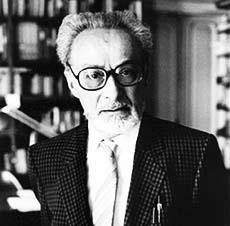
He has been recognised as one of the great writers. In his books he returns to the inhuman world of Auschwitz in a sober way, mainly dealing with people whom he had met there and in many instances admired. He had never judged but observed his inmates, trying to understand them. Through his writing he revealed himself.
One of the most common questions asked of Levi during his tours was whether the Germans knew what was happening during the war? “If they didn't know it was because they didn¹t want to know.” He acknowledged that “State terrorism is a very strong weapon” and difficult to oppose.
Twenty years after Primo Levi¹s tragic death, the people who work at the Holocaust Museum and Research Centre are being asked the same questions.
Only through reading, and better understanding of human nature and history, our answers might become more acceptable and better understood by our visitors.
21
Primo Levi
What one Christian does is his own responsibility, what one Jew does is thrown back at all Jews. Anne Frank, death camp victim (1929-1945)
Alien Roots by Anne Jacobs, published by Makor Library
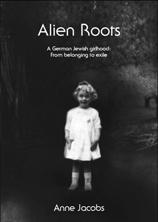 Helen Leperere
Helen Leperere
This is an engrossing book. The author takes us back to the Germany after World War 1, to a time when Germany - though defeatedstill indoctrinated the youth in the glory of Fatherland“ Deutschland Uber alles” (Germany above all), which perhaps foreshadowed the coming regime of Hitler.
Anne was born in 1918, at the end of the first World War, into a very wealthy family of bankers. There was also a younger brother Klaus, aristocratic and completely assimilated. Anne’s family was a large one. She describes in detail every member: aunts, uncles, cousins and grandparents.
Anne was no stranger to the English language, her grandmother having come from Australia, met her grandfather on holidays in Germany, and they married. Though Anne’s mother was fluent in English, Anne refused to speak it, being a proud German who should only speak in their own language.
She grew up in utter luxury, in a household of servants, governesses, private tutors and chauffers. The family socialized mainly with affluent Germans and the German Intelligentsia. Coming from Poland, I was personally amazed to read that the children were flown to Switzerland to recuperate after minor illnesses. Even as late as 1938, the family holidayed in different European countries.
We learn a lot about the mentality of German Jews, their preparations and celebrations of Christmas, down to the last detail, save for having a crib for the Holy Child. Anne’s parents decided that their children should have some education in Judaism and enrolled them into a group for Jewish studies. But their mother thought the company there too common for her children and took them out. Anne, however took to those studies and later became an enthusiastic defender of the Jewish race and culture.
After pogroms in Europe in the 19th century, Jews from impoverished countries started to immigrate to Germany. The local Jews treated them, especially Anne’s mother, with contempt, regarding them as some lower class of people. While arguing with her daughter on that subject, she said that Germany was a highly civilised country and would never allow any cruel pogroms to happen there.
In the years after 1934, we learn of the arrival of Hitler and the rise of anti-Semitism, anti-Communism, anti homosexuals and many other “antis”. With deep sadness and disappointment, Anne describes the change in her friends. All her life-long friends embraced the Nazi ideology and by then youngsters were forbidden to communicate with Jews. Some of her friends assured her that there were different kinds of Jews, and Hitler would not harm people “like her”.
By then Anne was 16. She sensed that the antiSemitism that was spread by Nazism was total. She suffered a lot, both from the loss of her friends and from
her deep disappointment with the politics of her beloved country. By now, the Jews of Germany, including Anne’s parents began to swallow the bitter pill of being ostracised from their life-long friends. Yet, Anne’s mother still insisted that Jews “like-us” would be exempted from Nazi atrocities.
GERMAN MENTALITY
Anne describes brilliantly the mentality of Germanstheir complete adulation of Hitler. He was their saviour. Though many disliked him, they followed his ideology closely. They gladly skimped and saved because they were ordered to do so. Some time later, when Anne travelled with her mother to Italy for holidays, she found the Fascism of Italy very different from the Nazism in Germany. One could breathe and be free there, she writes. One did not have to live in fear, looking over one’s shoulder, or be frightened of knocks at the door at night. The Italians were not cut out to be true Fascists.
After her mother understood that her children that were no longer comfortable in German schools, she (who seemed to be the decision maker of the family) decided to send them to an exclusive English boarding school. Though Anne recognized the relaxed atmosphere there, the freedom of thought during debating lessons, she could not relate to it, being indoctrinated with German strictness. She considered the standard of education in England much lower than in Germany. So she left.
Anne’s mother decided that Anne should be educated in a French speaking country. I was amazed that she sent her off to a Belgian convent. A Catholic Convent? When her life was not even in danger yet? Anne somehow took to that convent, and finished schooling there with pleasant memories. She was forced to kneel during prayers, but was allowed not to cross herself. It did not upset her though, as she had no strong religious beliefs of any kind. She had fond memories of the nuns that ran the convent.
Anne describes the year 1938 very vividly as the year of he the great exodus of German Jews, to wherever in the world was possible. By then, Anne’s mother (her father died previously) realised the danger. Through her connections she managed to acquire papers for Anne to leave for England and then came to Australia in 1940, followed by her mother and grandmother.
With her husband Charles Jacobs she had three children. Being of a strong character she worked as a volunteer at Kew Cottage, Brotherhood of St. Laurence and to other institutions.
I was amazed at Anne’s brilliant memory and intelligence. But above all it was her sense of humour that impressed me. I admired her honesty and selfawareness in describing herself as the “black sheep” rebellious and stubborn at home and in school. She writes about it such a humour that it makes the reader smile. She had an amazing ability to express her thoughts and feelings on paper. I would recommend this book very strongly. It gives us a personal account of what it was like for German Jews during Hitler’s regime.
22 BOOK
GERMANY IN HITLER’S TIME
REVIEW:
FAMOUS ABORIGINAL'S GREAT GRANDSON VISITS CENTRE
His visit to the Centre was a historic day for 15 year old Michael Russell, great grandson of Leo Cooper, who in 1938 led an Aboriginal Advancement League group to deliver a protest to the German Consul in Melbourne, against the treatment of Germany's Jews, especially on Kristallnacht.
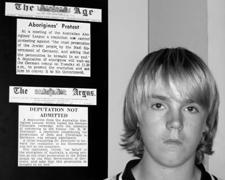
ceremony was held at the centre in 2003 to mark the Kristallnacht protest. There was standing room only, as Centre volunteers and men and women from all walks of life and members of the Aboriginal community, including spiritual leaders, came together. Aboriginal speakers told of a common bond between Jews and Aborigines and the vital need for all peoples to work together. It was unanimously declared "a truly amazing function." Sounds of the didgeridoo filled the hall.
The event received extraordinary coverage in the Jewish and non-Jewish media, including The Australian, Sunday and daily Age and ABC. The Jewish News devoted much space to the occasion.
Michael was delighted at the way the Centre had acknowledged the protest and being on Aboriginal land. It was very special because it also acknowledged his heritage.
Michael, with his school year 10 students, from Carnegie Education Centre, visited the Centre, gaining an insight into the Holocaust and combating racism, hatred and prejudice and fostering understanding among all sections of the Australian community.
Michael was extremely keen to hear Centre volunteers speak of his grandfather's actions, and see the two plaques, commemorating the 1938 protest and also acknowledging the Holocaust Centre was on the traditional land of the Kullin Nation. An Aboriginal delegation delivered the protest a few weeks after Kristallnacht (Night of the Broken Glass) pogroms on November 8, 1938. A special commemoration
Jon Carnegie, principal of the Carnegie Education Centre, said students had been affected by seeing the numbers on survivors' arms and experiencing, as much as they could, of the survivors' personal stories. It was a remarkable insight into how the human spirit could survive and carry on after such experiences. In many ways, it restored one's faith in human nature and the ability to survive.
Teacher Malia McCutcheon said: “This was the school’s first visit to the Holocaust Museum and it was very moving for one of our boys to see a relative who had been involved in the Holocaust. It really bought home the impact of events which until now had been contained in the pages of our history texts.”
HERR HONIG AND THE WANNSEE CONFERENCE
Gary Gray
“What is it you are reading?” I asked my Michelle when I delivered my grandson Casey. I picked him up from Hamerkaz Shelanu, my usual pleasant Wednesday afternoon duty.
“It’s a pretty big book” I remarked.
“It’s called “The Holocaust –the Jewish Tragedy” by Martin Gilbert, Michelle replied. “I can’t put it down.”
“Yes, I have heard of it, a fascinating book, I was told, with amazing details and depth.”
I picked it up. “Page 282 The Wannsee Conference, January 1942”, I read aloud.
“Dad, I haven’t reached that chapter yet. Do you know anything about the Wannsee Conference?”
None of us actually liked Hubert – Hubert Honig, I mean.
Years after the liberation when I heard John Kennedy’s speech and his famous ‘Ich bin ein Berliner’, my
thoughts went immediately to Hubert who came from Berlin and being so proud of it, used that expression so often in our barrack 3 slave labour camp. ‘Ich bin doch ein Berliner’ (I am still a Berliner).
No one could give a damn whether someone from our unfortunate comrades in misery who landed here in 1942-43 came from Berlin, Paris, Brussels or Amsterdam, so being a Berliner was certainly not a kavod (honour).
“Who does he think he is, that yekke pottz (German prick)” old Pilzer used to mumble in his Yiddish-German jargon.
But you see, Hubert Honig wasn’t really a yekke pottz. In his heimat (homeland) he was actually a big industrialist, in fact a high-ranking director of Krupp Worke, an industrial giant with so many plants spread right through Germany, a giant so well-known to most labour camp inmates, as so many of us had the “pleasure” of slaving in some of those plants.
Hubert himself was separated from his non-Jewish German wife, stripped from all his positions, arrested in one of those raids, sent to our slave labour camp and paradoxically finished up working in the nearby Krupp Worke plant wearing, like all of us, some dirty overalls,
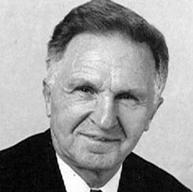
23
Michael Russell, great grandson of Leo Cooper.
*****
Gary Gray
schlepping cement, or shovelling coal into some furnace. Maybe our antipathy wasn’t so much attributed to his industrial background, but rather mixed with a bit of envy, especially when we saw him getting some parcels (not so unusual in 1942-43), or an occasional letter, from (as he pointed out to us so many times) some important people in Germany. We also saw him having friendly chats with some of our guards. Someone even suggested that his German wife left him or deserted him, but this he always denied with great genuine anger – we believed him.
German inmates, rich or poor, educated or simple, never lied, this we knew, so we also believed him when he brought us from time to time some news, optimistic news.
“His news is always too good”, David Krauskopf always maintained.
My friend Yumek worked with Hubert in the same commando (work venue). He actually liked him. “Gustav”, Yumek used to confide in me, “He’s not really so bad, you have to get to know him a bit closer. At work”, Yumek continued, he always shares with me a bit of this or that which some of the German workers used to drop secretly in his overall pockets.”
“Anyway, optimistic or not optimistic”, Yumek argued with David Krauskopf, “we need good news. Who needs bad news? Maybe good news gives us false hopes, but bad news can only bring us down.”
I never participated in those predictions. I didn’t know who was right or who was not. As a young teenager I probably didn’t comprehend the reality we were all facing. My reality was to be happy with the extra food I got from my friend Rosie and to wait for some news from mum and dad, still alive in Spring 1943, and to remember mum’s advice – “Keep clean, wash often, so you won’t get any lice.” That was my reality and in my situation not too hard to fulfil, at least not till the end of ’43.
Maybe that is why that sudden outburst by Hubert Honig shocked me so much. It was an April Sunday when the first, I think, transport of Dutch Jews arrived in our camp, well dressed, arriving by train, not cattle wagons, but passenger compartment train.
“Can you see”, someone commented in our barrack, “they got them here to work. They need our labour force. Otherwise why would they have to schlep them here from the West?”
CHILD SURVIVORS AWARDS
Floris Kalman and Eva Marks were awarded special certificates for their work for the Child Survivors of the Holocaust over many years. Floris has retired as president, with Henri Korn appointed in her place. Eva Marks was a founding treasurer and worked in the position for many years. She and Floris and Henri are also Holocaust Centre volunteers.
Picture shows Henri Korn, Eva Marks, Dr Paul Valent (founder of the Child Survivors, Melbourne) and Floris Kalman, at the group's March first meeting for 2007, a dinner gathering attended by 42 people. Henri Korn hopes to widen the activities, including getting other

“You fools”, someone with a hysterical scream, came out from the dark corner of the barrack. It was Hubert Honig.
“Meine leute, sint sie alle verrucked? (are you all crazy?), don’t you know what they are doing? Didn’t your hear about the Wannsee decision, the Wannsee Conference a year or so ago?”
The what conference?” our Stubenelteste (barrack head) Borenstein asked. “What are you talking about?”
“OK, I’ll tell you, but listen, and keep your mouth shut. The Wannsee Conference in January 1942, the details of which were given to me in great confidence by my old high-position friend Rudolf, a year or so ago, was a conference where the details of total destruction of European Jewry were discussed, planned and determined. The plan established by Heidrich with the cooperation of the Ministry of Justice, Ministry of Race and Resettlement, and the Office of Disposing of Jewish Properties, with the detailed method of concentration of Jews in ghettos, method of extraction of Jewish labour force, and with the help of the Ministry of Transportation, outlined the details of the Final Solution. That plan even outlined the method of fooling the people with the resettlement theory, and that’s why”, Hubert continued, “they are transporting them from the West in passenger trains.”
Total silence covered the room that Sunday night when Hubert Honig turned around, pale and shaking, and climbed up onto his upper bunk and lay on his straw mattress in Barrack 3.
“What did he say” the voice of Borenstein asked, “was the name of that thing?”
“The Wannsee Conference”. Some other voice answered.
“Yes Michelle, I do know a bit about the Wannsee Conference.”
P.S.: Hubert Honig was a few weeks later, taken away somewhere. It was a bit strange, as he was transported solo, with a guard, not with other prisoners. “Maybe he was by some protekcja taken to a better camp”, someone remarked, as we couldn’t see any worry on his face; in fact he smiled and waved to some of us as he was crossing the gate of Ludwiksdorf.
We never did find out what happened to him.
groups to become involved. The Child Survivors are on the Holocaust Centre's Board. For further information contact: Henri Korn at 9528 1027.
24
*****
THE FASCINATING STORY OF GERMAN MIGRANT
Jayne Josem reflects on her encounter with a remarkable Australian from Germany
When researching content for the recent “Shelter from the Storm” exhibition at the Jewish Holocaust Centre, I contacted an elderly Jewish woman in Adelaide, Hilde Hines. Hilde and her husband, Gus, had escaped the terror of Nazi Germany just prior to the outbreak of war and were fortunate to have permits to migrate to Australia.

Over the ensuing months I had many phone conversations with Hilde and she sent me a copy of her unpublished memoirs. She was nearly 90 and was desperate to see her writing published. I found it to be full of information that was helpful to my research, but when she asked me about publishing them I had to be frank.
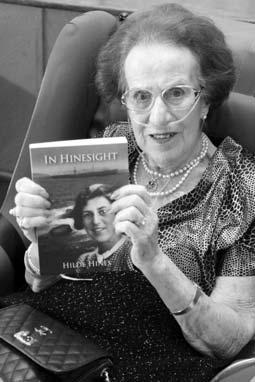
I felt that within the pages she had written was a powerful story about German Jewish refugees escaping Hitler and living in Australia as “enemy aliens” during the war; however there was also a lot of extraneous material about the fate of cousins and friends that made it confusing to read and diluted the main narrative.
As soon as I uttered those comments to Hilde, I felt pangs of guilt. Who was I to make such remarks to a wonderful woman who had taken a lot of trouble to so eloquently pen theses words? So when she asked if I would be so kind as to suggest how to edit it into a more readable story, I felt I could not say no. Hilde was of sound mind yet frail of body and was desperate to see her words I print before she died.
I thought of how Hilde had been a tireless worker for the benefit of others. I thought of how much I missed my German grandmother Tilly, who would have been of a similar age to Hilde had she lived longer. I agreed to help.
Towards the end of 2006 I was asked to write a blurb for the book cover. The words flowed easily. I started with Hilde’s own words:
“Having grown up in Germany, I experienced first hand the hatred and wickedness of the Nazi regime. Seeing my family grow and prosper today brings a smile of victory to my
face, a victory against the madman who tried to annihilate my family and my nation. The Guckenheimer and the Heinsfurter families, whose ancestors had lived for many centuries in Germany, are now spread all over the world –not of their own volition but through the policies of Hitler and the Nazis.”
EXTRAORDINARY TALE
Then I summarized the book:
“In these pages a remarkable Australian migrant tells an extraordinary tale. Now nearly 90, Hilde Hines recalls her life journey, from the innocence of her childhood in Nuremberg, Germany, through the changes that the Nazi regime forced upon her world, simply because of her family’s Jewish faith.
“Fortune smiled on Hilde and, with her husband Gus and his mother, she escaped Europe as war was raging. While Hilde and Gus were struggling to start their lives anew in Adelaide, Hilde’s mother and sister spent the war years amid the bombs in London. Correspondence between Adelaide and London provides a unique insight into their respective situations.
“Gus and Hilde’s tireless efforts and determination to succeed enabled them to re-establish themselves in this strange and foreign land. Hilde documents their achievements: starting a family, building a successful business and becoming active community members.”
In 2007 I was overjoyed to be invited to the launch of Hilde’s book “In Hinesight” on 1 February 2007, by Alexander Downer, Minister for Foreign Affairs. As the book was to be launched in her hometown of Adelaide, I could not attend, but I was pleased to hear that members of her large family traveled from near and far to be with her for this special event.
Hilde herself had become very frail and was taken from hospital to attend the launch. I was saddened to hear that Hilde died two days later, surrounded by her extended family who had flown in for the launch. It warms my heart to know that she did at least see her words in print.
25
Foreign Minister, Alexander Downer with Hilda Hines at the launch of her autobiography.
Hilda Hines with her book, “In Hinesight”.
MONTREAL HOLOCAUST MUSEUM — TO LEARN. TO FEEL. TO REMEMBER.
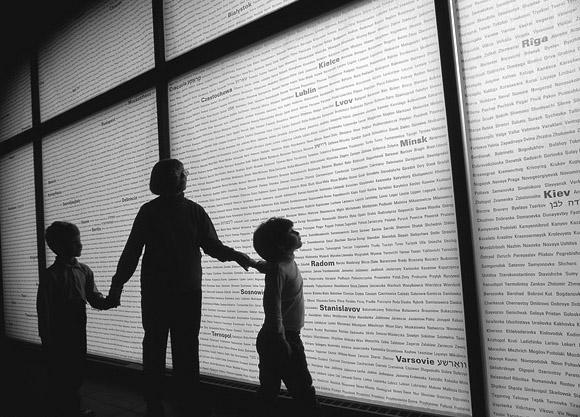
Montreal Holocaust Memorial Museum plays a leading part in Canada’s keeping alive, in both the English and French languages, the message of the Holocaust.
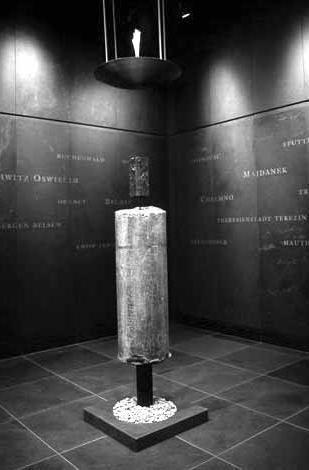
The Museum’s mission is to educate all people of all ages and backgrounds about the Holocaust while sensitising the public to the universal perils of antiSemitism, racism, hate and indifference. It is dedicated to promoting respect for diversity and sanctity of all human life. Canadian survivors claim that the Museum is in keeping with the observation that memory was a sacred act and transcended religion.
The Museum’s Miriam Rabkin, Communications, Education and Outreach Coordinator, has sent Centre News details about the Montreal Museum background and aims, with photos by Pierre S-Jacques.
The two-level Museum is the nation’s longest memorial to the Holocaust, dedicated to raising awareness about human rights through the study, documentation and interpretation of Holocaust history.
Montreal after WW11 became a haven for approximately 30,000 survivors, then about a third of the city’s 100,000 Jews, with many speaking Yiddish. Montreal at that time was still the financial and cultural centre of Canada’s largest Jewish population, and with a very renowned community spirit. It is believed the city has around 6,000 survivors today.
In 2003, more than 1,000 people attended the inauguration of the new upgraded Museum, dedicated solely to the Holocaust. It is an expansion of the memorial centre founded in 1979. The initial discussions about the extent of the new museum led to various philosophical differences. The balance meant not simply looking at the Holocaust, but putting the atrocities in perspective by showing the history and
diversity of Jewish life in Europe from 1850 through both World Wars and then explaining what occurred to survivors after 1945.
The desire to move Jews from objects to subjects. To show not only how Jews were treated, but how they responded. They resisted, with initiative and vitality.
The museum in 2003 was given a $5 million annual budget, funded through government grants and private and corporate sponsors.
It employs highly professional archivists, administrators and marketing and public relations people. Marketing and PR are key day-to-day aims. The museum ensures the story is told of the whole Holocaust era and not only of people who did all they could to survive but did it with dignity. Prospective volunteers must commit to 60 hours of classroom instruction and 60 more of training in the museum itself.
The overall goal of the museum’s Holocaust exhibitions could be described as a catalyst for future thought. Not just to come in, maybe cry and then not want anything more to do with the experience as it was too painful.
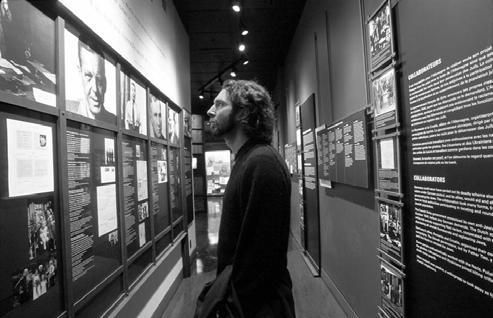
Museum visitors are greeted by the words of Elie Wiesel “Not to transmit an experience is to betray it.”
The Museum’s narrow space and sharp angles have been described as adding to a visits tension. You turn a corner and there is a video of a book burning. As you leave the lift at the second level, you hear a BBC announcement that Germany has invaded Poland. You feel Europe’s tragic conditions, with fewer places to sit, fewer chances to look away and escape. The lessening of comfort is deliberate.
A visit to the Montreal Museum, with its universal message, is well worthwhile.
26
A selection of photos of the Montreal Holocaust Memorial Museum. (Photos: Pierre St. Jacques)
IMPORTANCE OF HOLOCAUST STUDIES
Mariela Sztrum, Education Officer Sydney Jewish Museum
The Sydney Jewish Museum (SJM) education programs focus on the history and lessons of the Holocaust to foster cross-cultural understanding among different communities in New South Wales.
simultaneously treated to outstanding lectures in Holocaust history. Lecturers included: Professor Konrad Kweit, Roth Lecturer in Holocaust Studies at the University of Sydney, SJM Director of Education Avril Alba, Drs. Sharon Kangisser-Cohen, Dr Dirk Moses, Michael Abrams-Sprod from the University of Sydney and Dr. Julie Kalman from the University of New South Wales. Currently 60% of the course participants are actively guiding in the Museum. Ongoing weekly guide education lectures gives these new guides the space to continue to learn and refine their skills. Without the volunteer guides’ support and dedication the Museum could certainly not function in its current form.
The Education Department oversees all education initiatives at the SJM including schools programming, training of new and existing guides, professional development opportunities for NSW teachers and educators in the areas of Holocaust history and research and a variety of tertiary initiates, such as Fellowships and prizes in Holocaust- related research for Honours and Masters level students at NSW Universities.
The Holocaust is not included as a mandatory topic in the NSW syllabus. The challenge for the SJM’s Education Department is to make meaningful connections with the key syllabus areas in which a consideration of Holocaust history can enrich student learning.
In so doing, the Sydney Jewish Museum has developed seventeen education programs catering for History, HSIE, English and Studies of Religion subjects, as well as cross curricular and programs for Gifted and Talented students. Last year 12,800 students attended the Museum and numbers are expected to increase for 2007. Some of the students’ comments are included at the conclusion of this article.
In 2006 the SJM’s Education Department sought to evaluate the impact of the Museum visit upon the students. Short and long term impact was assessed through a study undertaken by a research group on behalf of the SJM. While the results were overwhelmingly positive, the outcomes were vital in implementing new initiatives and continuing the effectiveness of existing programs. The focus groups involved students from private and public high schools in NSW, in junior and senior years, who had visited to the Museum in 20032005.
220 VOLUNTEERS
The Museum has 220 Volunteers, of which 62 are second and third generation guides and 39 Survivor guides. All Holocaust programs include Survivor testimony. In 2006 the SJM trained 43 eager second and third generation participants to become guides. The intensive course, Generation to Generation, lasted 14 weeks and focussed on the complementary areas of Holocaust history and memory.
Participants were honoured to receive personal mentorship from SJM Survivor guides and were
The SJM also provides a variety of opportunities for teacher training and professional development. Two information evenings for senior educators and administrators took place at the Museum in March. Two intensive teacher training workshops are scheduled for May. For those teachers interested in pursuing further training in this area are encouraged to apply for the Museum’s competitive Blashild Fellowships in Holocaust Education.
In January, seven teachers and educators from NSW and ACT attended the International Seminar for Educators at Yad Vashem as part of the Blashild Fellowship 2006 - 07. The Fellowship consists of a preseminar at the SJM and the course at Yad Vashem. On their return participants commit to developing and implementing a project in Holocaust Education with their students. A Plenum to assess the impact of their projects will take place at the Museum on the 22nd July.

Recently a joint program took place, fostered by the NSW Jewish Board of Deputies, between Masada College and the Hamazkaine Arshak and Sophie Galstaun School from the Armenian community. Students in year 9 from both schools attended the Sydney Jewish Museum.
Holocaust Survivor Eddie Jaku and Armenian speaker Armen Samuel Karamanian gave an account of their history during the Holocaust and the Armenian Genocide. The event was highly successful in creating the atmosphere for a better understanding between the two communities, one that will certainly develop in time.
The Sydney Jewish Museum is both a memorial and an educational institution which prides itself in continuing the legacy of those Holocaust Survivors who found a home in Australia and value Jewish life and culture. The Education

27
Holocaust Survivor Eddie Jaku with Armenian speaker Armen Samuel Karamanian.
Blashild Fellows at Yad Vashem. From left to right: Bridget Punch, Rebeccah Bartlett, Rebecca Goldberg, Rebecca Gaida, Steve Green, Irit Ben Nissan and Hayley Diamond.
Department aspires to continue this legacy into the future through the growth and consolidation of quality educational programming.
Quotes:
“The Museum was…incredible. It made everything so much more real. I never understood before just how bad the Holocaust was. I was sympathetic, but now I can feel empathetic towards it..” Anabelle Nursey, Year 9. Tara Anglican School for Girls, November 2006.
“Due to my visit to the Sydney Jewish Museum I now want to learn more about what happened and have started a new goal, gathering information, picture to help me understand and to further my knowledge.” Michelle Richards, Year 9, Bankstown Grammar School. October 2006.
(When in Sydney, you will be made welcome at the Museum, and can exchange ideas with survivors and others. We must all work together to get the message of the Holocaust to the widest public.)
SURVIVOR ART WORKS SOUGHT
Holocaust survivors can have their art works exhibited as part of the permanent collection of the Cunningham Dax Gallery. Gail Rockman, an arts therapist, has been approached by the director to search and collect art works that survivors (including 2nd generation) may have created either privately of in art therapy sessions. The director has wishes to include a "Trauma" section within their gallery and is specifically interested in the Holocaust; therefore the art works that Gail is searching for would be the creative representations of experiences during and post war.

The Cunningham Dax collection consists of creative works by people who have had psychological trauma and houses over 10,000 works. The mission of the
Collection is to promote widely a greater understanding of people who have had traumatic experiences, and to foster an appreciation of their creativity through the preservation and ethical presentation of their original works. The collection has an on-site exhibition of over 100 works, is open to the public and is visited by groups from a broad range of interests, especially secondary school students.
Gail Rockman said this was a special opportunity for the Jewish Community to have Holocaust works in such a well known gallery. Importantly the art works of survivors will be exhibited in a non-Jewish public place at a time when so many people need to be reminded of the Holocaust!
Contact Gail by email or mobile phone if you have in your possession, or know of drawings, paintings, ceramics or sculptures that exist by other family members: mobile: 0414 599 669 or g.rockman@optusnet.com.au
SURVIVORS’ WORK IN CANADIAN UNIVERSITY
Works by Australian survivors, including Centre volunteers, are included in the vast collection of Holocaust books at the Holocaust Literature Research Institute in Canada’s University of Western Ontario.
Professor Alain Goldschlager, Director of the Institute explained how the impressive collection began.
presses or at author’s expenses and are outside the normal distribution system.
There is also the feeling that once the story is published, it is safe to the opposite of oral history. Unfortunately this is far from being the case and we have lost so many testimonies by neglect.
I started collecting because I could not find the books in libraries. I then established the Institute in 1996 to protect and extend the collection and place it on the Internet in a scholarly useful way.
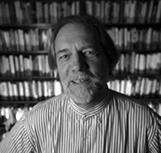
The collection has over 2,500 volumes in 15 languages (I received the first 2 in Slovac).
He said: “While I was participating at Holocaust denier trails as a researcher for the prosecution, I realized the importance of testimonies but also that it was quite difficult to find them since they were not extensively recorded except the great ones (Anne Frank, Primo Levi, Elie Wiesel).
I started a bibliography only to find out that no library was systemically collecting them. Indeed the texts are often published in small presses or vanity
I estimate that the total production of Holocaust testimonies is likely between 15 and 20,000 max. The website gives annotated information on more than 4,000 volumes. It can be accessed from anywhere in the world and gives various and useful information on the texts.
The case of Australia is interesting.
I have around 35 books in the library and almost 80 in the database. I surely hope to extend that part of the collection. At the present time, outside of the website, the collection is used by a series of students and colleagues from the university.
Several Master’s dissertations were written using it and I have three Ph.D’s on the way.” http://www.hlri.ca/
28
Gail Rockman
Professor Alain Goldshlager.
SCHOLAR AT JOINT MELTON AND CENTRE EVENING
As part of the 10 year celebrations for The Florence Melton Institute of Melbourne, the Centre hosted an evening session, chaired by Dr. Mark Baker, and with acclaimed US based Israeli scholar and Jewish Studies educator Dr Zohar Raviv.

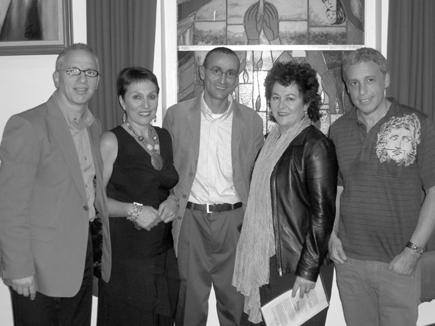
This seven-time “March of the Living” leader, based at Oberlin College in Ohio spoke on “Embracing Auschwitz: the Perils Of Our Holocaust Narratives”. Raviv gave his views on appropriate reconstruction of memory of the Holocaust and its important biblical and historical context.
Almost apologetic for having not lost loved ones in the Shoah himself, Raviv contended that survivors are “martyrs of silence with a vision for the void”, with some accepting divine intervention and others only discussing the moral meaning. He elaborated on the Holocaust being a Jewish event as opposed to an event that happened to the Jewish people.
As a former participant and now an experienced leader of student “March of the Living”, Dr. Raviv advocates for youth to honour the memory of the victims, not by contextualizing the ashes of Auschwitz and the numbers that died between 1933-45, but by remembering the difference that Jews made by putting a human face to the magnificence of the Jewish world that
existed in the 2000 years they lived in European communities, and then the calamity it became. He added “intent is designed by God, but actions are not”.
Mark Baker said it is not easy for many to forget the ashes and the numbers. While Dr. Raviv projects Judaism in continuity, Dr. Baker’s understanding of Judaism is that it isn’t a smooth road, one that is constantly interrupted by Chagim that created movement and change, such as Pesach.


ARGENTINIAN ACADEMIC VISITS CENTRE

29 BUY AN ENTERTAINMENT BOOK “The EntertainmentTM Book” is the only Book you’ll need. Find the best restaurants, hotel accommodation, attractions, sports and leisure activities all with 25% to 50% off or 2-for-1 offers. $60 each (incl GST) Contact: Lena Fiszman 9528 1985 or Email: friends@jhc.org.au 13-15 Selwyn Street Elsternwick 3185
Charles and Leah Justin, Zohar Raviv, Pauline Rockman and Mark Baker.
The Centre was honoured recently by the visit of Argentinian Holocaust academic and Vice-President of the “Fundación Memoria del Holocausto”, Buenos Aires, Argentina, Dr. Enrique Ovsejevich.
Bernard Korbman, Pauline Rockman and Dr. Enrique Ovsejevich
ACQUISITIONS: SEPTEMBER 2006—JANUARY 2007
Ursula Flicker
The following are the latest additions to our collection:
Burnt out copy of volume of “Anthologia Hebraica” saved from Synagogue in Lvov Poland.
Donor: Mr. Arkady Levin
Book titled “Some Conclusion in the Heart” and Video titled “Complete Post” both by donor dealing with poems written by him. The highlight is poem titled “Kristallnacht”
Donor: Mr. Grant Fraser
Photograph taken whilst on a visit by donor to Berlin Holocaust Museum of the photograph of “The Theresienstadt Boy”. Otto Kohn was there during a visit by the Red Cross to the Camp on July 23, 1944. He survived and now lives in Australia.
Donor: Mr. Tuvia Lipson
3 framed pictures of Anti-Semitic posters made circa 1937
Donor: Mr. Michael Kaukas
Polish army uniform and other military paraphernalia together with photographs and documents of Edward Censor, who fought in the Polish Army in exile.
Donor: Mrs. Gwendoline Schwarz
Siddur in German belonging to late mother Gusti Gross who perished in Auschwitz circa 1942
Donor: Mr. Max Gross
CD containing “The Collection of Gross Breesen. Letters and Related Material named “A Testament of the survivors, a memorial to the dead”” compiled by the donor on the 70th anniversary of the founding in Gross-Breesen (Brzezno) in Poland, as a training farm for young Jewish people.
Donor: Mr. Herbert P. Cohn
Booklet in German titled “Sachsenhausen – Liederbuch”, re-print version 1995, presented in 2006 to the donor by Professor Gunter Morsch on visit to the Camp where Max Stern was interned.
Donor: Mr. Max Stern
Additional correspondence, documents and photographs for the catalogue holding of Survivor and Guide at the Museum.
Donor: Mrs Sonia Wajcman
2 Yellow stars, Newspaper article, and other documents of Holocaust survivors Bernard and Sarah Frucht (formerly Fruchtzwajg)
Donor: Mr. Mark Zuker
6 letters, 4 postcards and notice from father of donor kept by the Polish (Christian) cobbler in Lublin, retrieved after the war.
Donor: Mr. Henry Buch
Addition to our Museum’s “Cherished Children project”. 2 photographs of unknown family and boy on a scooter, children victim of the Holocaust.
Donor: Mrs. Leonie Ben-Simon
15 Photographs taken by un-known photographer at time of liberation of Bergen-Belsen Concentration Camp in April 1945.
Donor: Mrs. Janine Simpkin
Postcard written by an Ester Rosen in the Lodz Ghetto in 1941 to her daughter, then in Russia.
Donor: Mrs Guta Akerman
The Centre’s Archives asks more donors to bring their treasured documents, objects and artefacts to it for safekeeping. All items about the Holocaust are important to reconstruct the past.
30
PERSONAL ANNOUNCEMENTS
Birthdays
Stephen Pinch, Alice Halasz, Phillip Ross, David Frelichs, Uszer Kozlowski, Pesia Helfenbaum, Henry Salter, Ronnie Issko, E. Ringelbaum, Lusia Lenk, Shirley Krongold, Erna, Eri, Kitia Altman, Danny Schwarz, Nathan Kamien & Gary Dembinski.
Wedding Anniversaries
Elma & Woolf Sacks
Fred & Shept Glass
Congratulations
Hearty Mazel Tov to Stan Marks on receiving his OAM Barmitzvah / Batmitzvah
Jack Ormut (Hong Kong)
Hannah Gersh Wedding
Jeremy & Gillian Snow
Condolences
Anne Bernhaut’s family In memory of Helen Lawner
JEWISH HOLOCAUST CENTRE COMING EVENTS
SUNDAY 29 APRIL 8.00PM
PROFESSOR HAIM MARANTZ MEMORY, HISTORY, MUSEUMS & THE HOLOCAUST BOOKINGS REQUIRED
THURSDAY 17 MAY 12.30AM
PROFESSOR DOUG GREENBERG CEO, SHOAH FOUNDATION LUNCHEON WITH STAFF, GUIDES AND VOLUNTEERS
THURSDAY 31 MAY 7.30PM
ANNUAL GENERAL MEETING JEWISH HOLOCAUST CENTRE
MONDAY 4 JUNE 7.30PM
GUEST SPEAKER: DANIEL MENDELSOHN AUTHOR OF “THE LOST”
SUNDAY 24 JUNE 8.00PM
GUEST SPEAKER: RABBI JONATHAN MAGONET PRINCIPAL, LEO BAECK COLLEGE, LONDON BETH WEIZMANN
360 HAWTHORN ROAD, CAULFIELD
TUESDAY 24 JULY 8.00PM
GUEST SPEAKERS: CARDINAL IDRIS CASSIDY REV. TIM COSTELLO RABBI FRED MORGAN
THE EFFECT OF THE HOLOCAUST ON CHRISTIAN & JEWISH THEOLOGY BOOKINGS REQUIRED
Printedby:EllikonFinePrinters,Fitzroy,Victoria.Australia
31
We are pleased to support the JEWISH HOLOCAUST CENTRE INC. and the publication of CENTRE NEWS
As a result of our achievements and fundraising efforts this last year we have been able to allocate:
$10,000 to sponsor the publication of a book “LESS and MORE” of our Museum’s Photographic Exhibitions by Saba Feniger our first Curator.
$20,000 towards funding a Development Manager for the Museum.
$5,000 TO THE 2006 MEYER BURSTON SCHOLARSHIP awarded to: Natalie Krasnostein whose project involved 3rd Generation participants’ workshop, progressing to a play to be performed next year. She has also presented a synopsis of the workshop at Limmud Oz and Yad Vashem/
$5,000 has been allocated to Jayne Josem our current Curator for an Overseas Study Tour of Holocaust Museums.
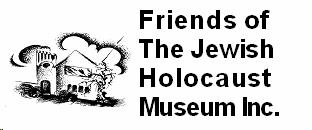
$3,300 to sponsor Shoshana Jordan’s Photographic Exhibition “the fabric of memory”.
Elly Brooks: President of the Friends of the Jewish Holocaust Museum Inc. www.jhc.org.au or Email: friends@jhc.org.au
WE INVITE YOU TO BECOME A FRIEND
MEMBERSHIP APPLICATION FORM 1July 2006
- 30 June 2007
NAME
ADDRESS
PHONE EMAIL
MEMBERSHIP FEE $25 Per Person o friends o young friends 21 - 35
MEMBERSHIP FEE $45 Per Family o friends o young friends 21 – 35
MEMBERSHIP FEE $15 Single Concession.
AMOUNT TOTAL
Please enclose cheque or provide credit card details below
o Visa o MasterCard o Bankcard o Diners' Club o American Express
Card No Expiry Date / Cardholders’ Name Signature
32







33
www.kligerwood.com.au

ESTATE AGENTS, AUCTIONEERS, PROPERTY MANAGERS, VALUERS
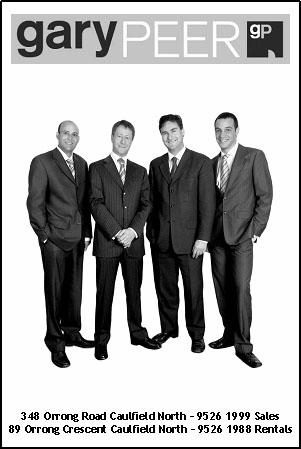

DIRECTORS
Barry Novy & Eugene Wood
ASSOCIATE DIRECTORS
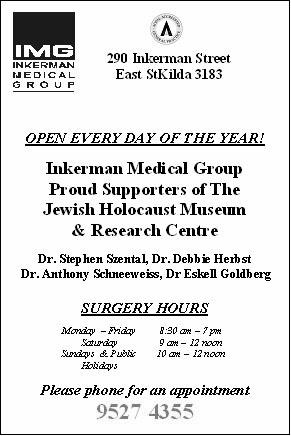
Nicholas Breheny & Rogan Sedger
Proud of our reputation for excellence in professional property services for 66 years.
34



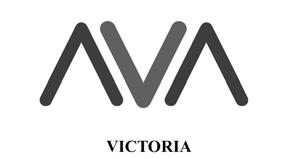
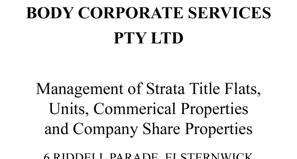


35 With the Compliments of Harry Blatt Pharmacy 781 Glenhuntly Road Caulfield South Ph. 9523 9695
GIVE YOUR SURVIVOR TESTIMONY



We want to hear from all survivors and to record their vital testimonies. This is especially urgent for future generations.
Over the years, the Holocaust Testimonies Department, part of the worldwide project under the patronage of Yad Vashem, has recorded more than 1,200 testimonies of Holocaust survivors. These have become a living record of what happened to men, women and children during the Nazi Era, and an answer to those who deny the Holocaust occurred. Have you given your testimony yet? If you haven’t, please call:
Phillip Maisel 9527 6282 or Holocaust Centre 9528 1985

36
MAKE A PLEDGE MAKE A PLEDGE
HAVE YOU CONSIDERED DONATING TO THE HOLOCAUST CENTRE?
PLEASE HELP US MAINTAIN THE CENTRE AND KEEP ALIVE THE HOLOCAUST’S MESSAGE AND THE MEMORY OF ITS VICTIMS.

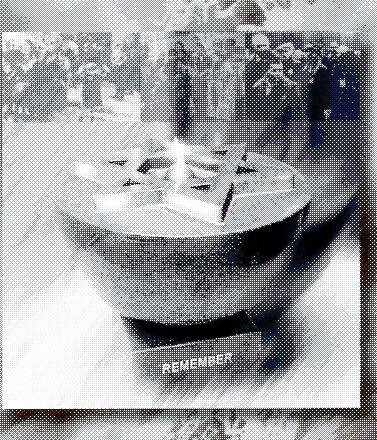
WE MUST KEEP THIS LEGACY ALIVE FOR THE FUTURE WE MUST KEEP THIS LEGACY ALIVE FOR THE FUTURE
I pledge the amount of $
Name
Address
Credit Card Bankcard Visa Mastercard Amex
Number
Expiry Date /
Please make cheques/credit card payments payable to: JEWISH HOLOCAUST CENTRE INC.
Credit Card Payments can be made by: Phone: 9528 1985 Fax: 9528 3758 OR Email: admin@jhc.org.au
ALL DONATIONS ARE TAX DEDUCTIBLE
15 Selwyn Street, Elsternwick VIC 3185
37
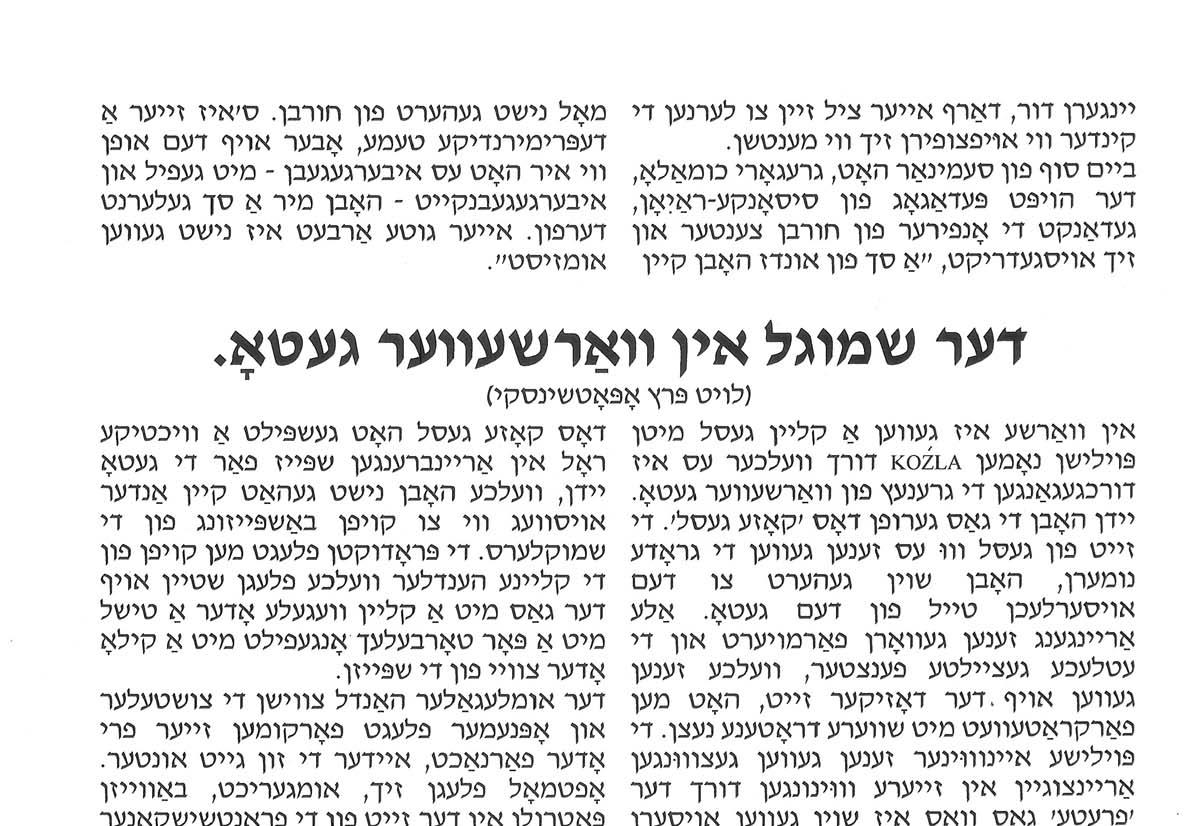

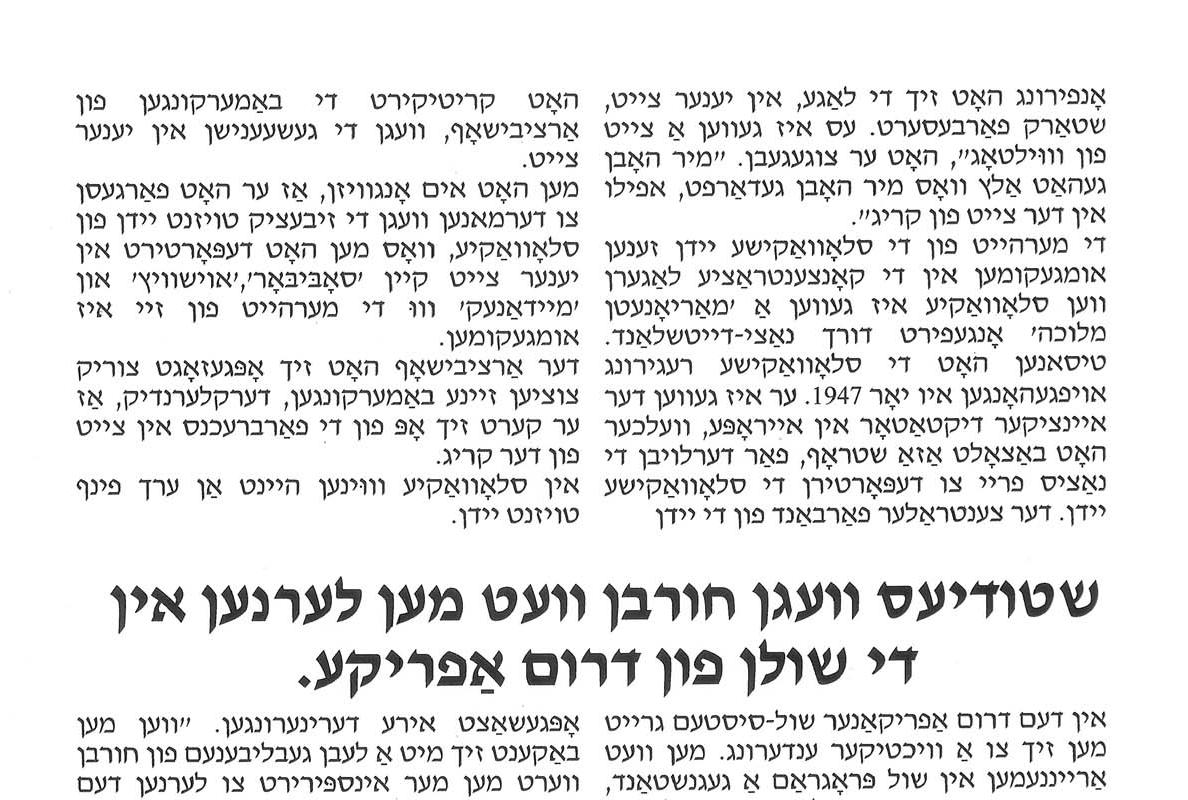
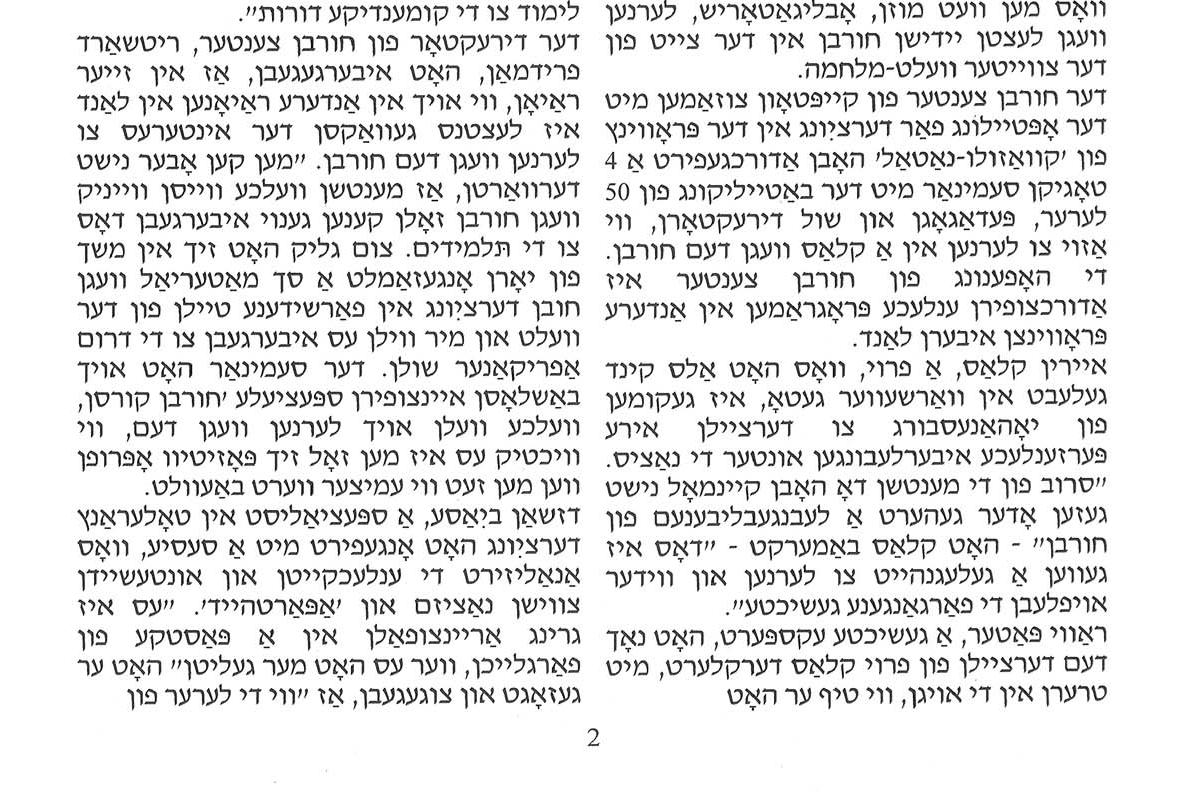
39
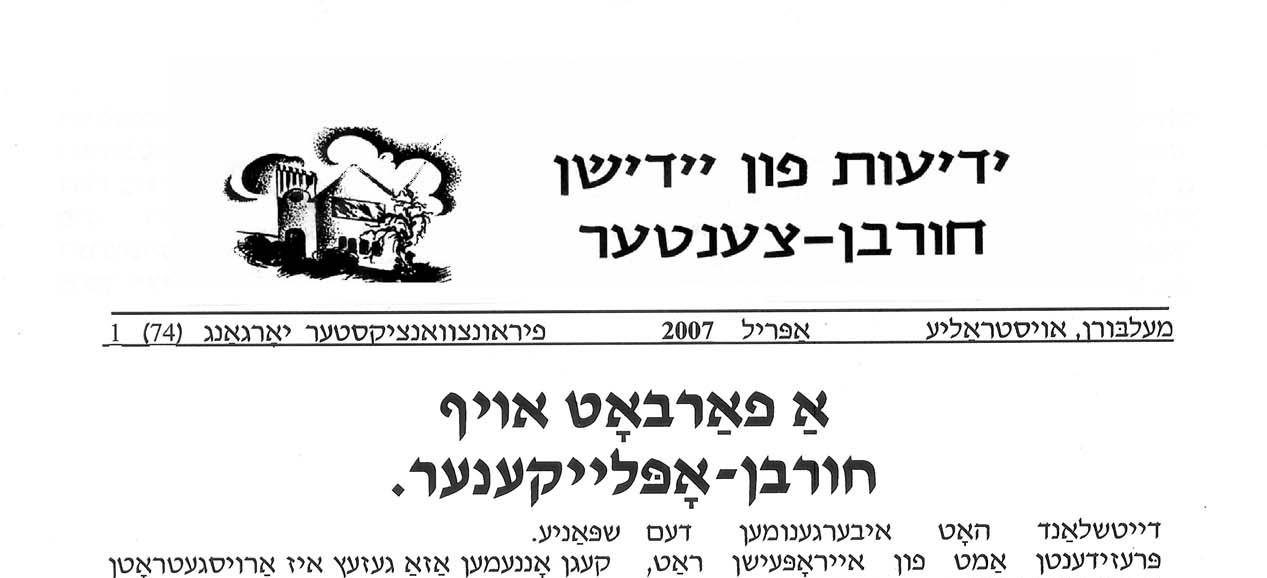
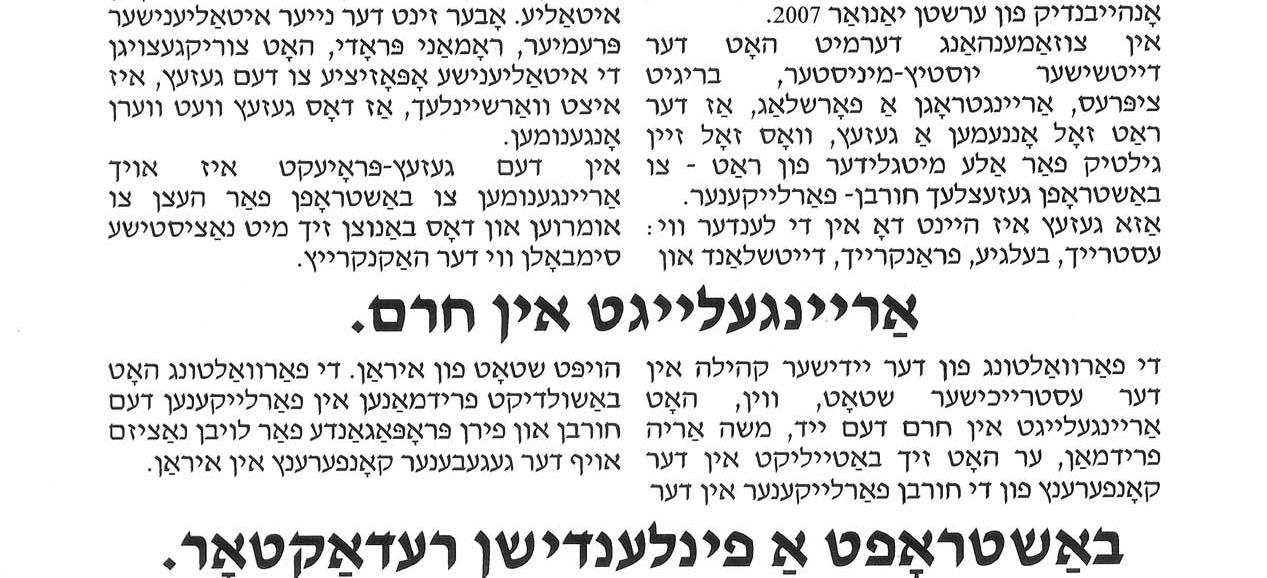















 John Boyne
John Boyne























 Helen Leperere
Helen Leperere
















































